Understanding Outcomes and Outputs
VerifiedAdded on 2020/06/04
|23
|6924
|231
AI Summary
This assignment focuses on differentiating between project outcomes and outputs. It emphasizes that while outputs reflect tangible deliverables, outcomes measure the value or impact achieved through those activities. The provided text explains this distinction using examples and references to academic sources.
Contribute Materials
Your contribution can guide someone’s learning journey. Share your
documents today.

Secure Best Marks with AI Grader
Need help grading? Try our AI Grader for instant feedback on your assignments.
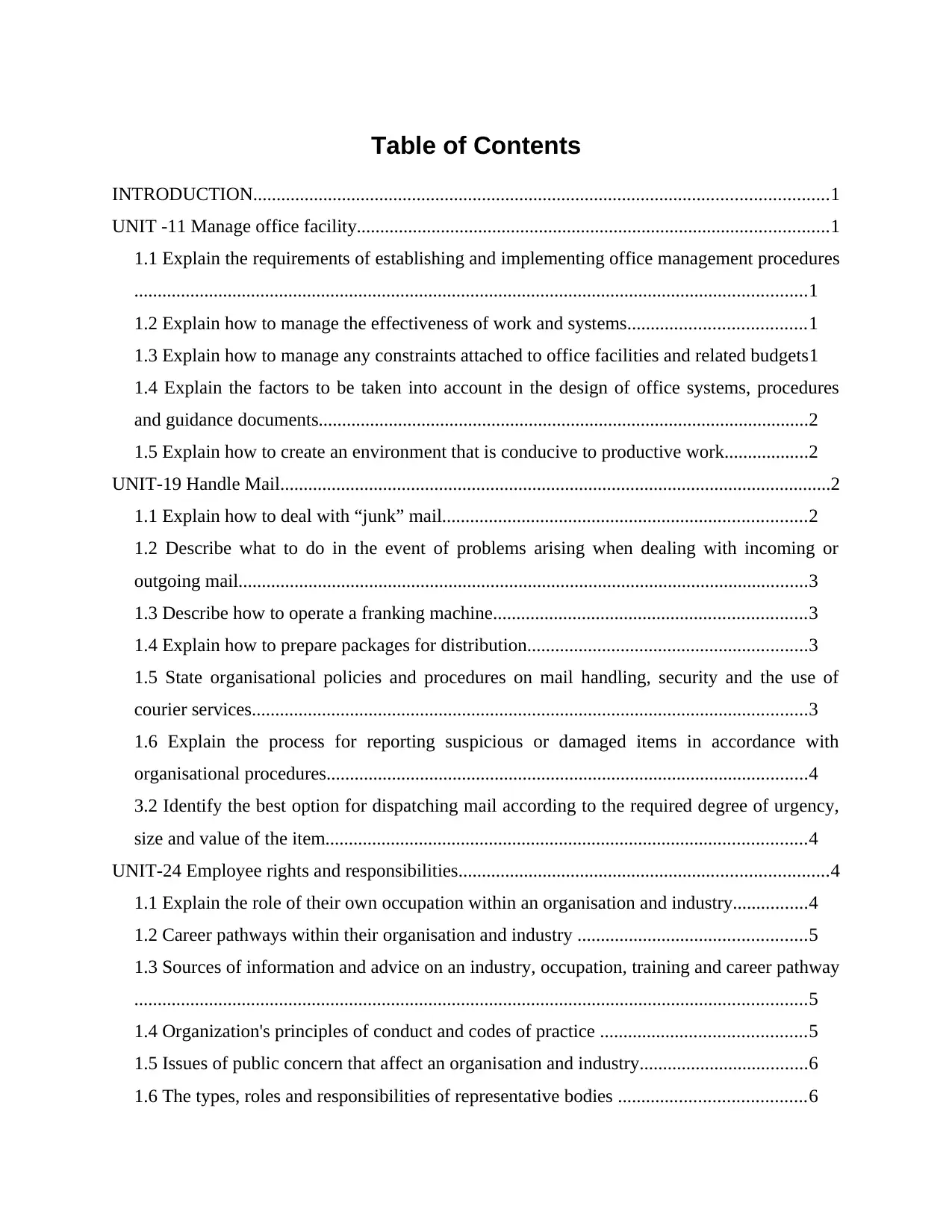
Table of Contents
INTRODUCTION...........................................................................................................................1
UNIT -11 Manage office facility.....................................................................................................1
1.1 Explain the requirements of establishing and implementing office management procedures
................................................................................................................................................1
1.2 Explain how to manage the effectiveness of work and systems......................................1
1.3 Explain how to manage any constraints attached to office facilities and related budgets1
1.4 Explain the factors to be taken into account in the design of office systems, procedures
and guidance documents.........................................................................................................2
1.5 Explain how to create an environment that is conducive to productive work..................2
UNIT-19 Handle Mail......................................................................................................................2
1.1 Explain how to deal with “junk” mail..............................................................................2
1.2 Describe what to do in the event of problems arising when dealing with incoming or
outgoing mail..........................................................................................................................3
1.3 Describe how to operate a franking machine...................................................................3
1.4 Explain how to prepare packages for distribution............................................................3
1.5 State organisational policies and procedures on mail handling, security and the use of
courier services.......................................................................................................................3
1.6 Explain the process for reporting suspicious or damaged items in accordance with
organisational procedures.......................................................................................................4
3.2 Identify the best option for dispatching mail according to the required degree of urgency,
size and value of the item.......................................................................................................4
UNIT-24 Employee rights and responsibilities...............................................................................4
1.1 Explain the role of their own occupation within an organisation and industry................4
1.2 Career pathways within their organisation and industry .................................................5
1.3 Sources of information and advice on an industry, occupation, training and career pathway
................................................................................................................................................5
1.4 Organization's principles of conduct and codes of practice ............................................5
1.5 Issues of public concern that affect an organisation and industry....................................6
1.6 The types, roles and responsibilities of representative bodies ........................................6
INTRODUCTION...........................................................................................................................1
UNIT -11 Manage office facility.....................................................................................................1
1.1 Explain the requirements of establishing and implementing office management procedures
................................................................................................................................................1
1.2 Explain how to manage the effectiveness of work and systems......................................1
1.3 Explain how to manage any constraints attached to office facilities and related budgets1
1.4 Explain the factors to be taken into account in the design of office systems, procedures
and guidance documents.........................................................................................................2
1.5 Explain how to create an environment that is conducive to productive work..................2
UNIT-19 Handle Mail......................................................................................................................2
1.1 Explain how to deal with “junk” mail..............................................................................2
1.2 Describe what to do in the event of problems arising when dealing with incoming or
outgoing mail..........................................................................................................................3
1.3 Describe how to operate a franking machine...................................................................3
1.4 Explain how to prepare packages for distribution............................................................3
1.5 State organisational policies and procedures on mail handling, security and the use of
courier services.......................................................................................................................3
1.6 Explain the process for reporting suspicious or damaged items in accordance with
organisational procedures.......................................................................................................4
3.2 Identify the best option for dispatching mail according to the required degree of urgency,
size and value of the item.......................................................................................................4
UNIT-24 Employee rights and responsibilities...............................................................................4
1.1 Explain the role of their own occupation within an organisation and industry................4
1.2 Career pathways within their organisation and industry .................................................5
1.3 Sources of information and advice on an industry, occupation, training and career pathway
................................................................................................................................................5
1.4 Organization's principles of conduct and codes of practice ............................................5
1.5 Issues of public concern that affect an organisation and industry....................................6
1.6 The types, roles and responsibilities of representative bodies ........................................6
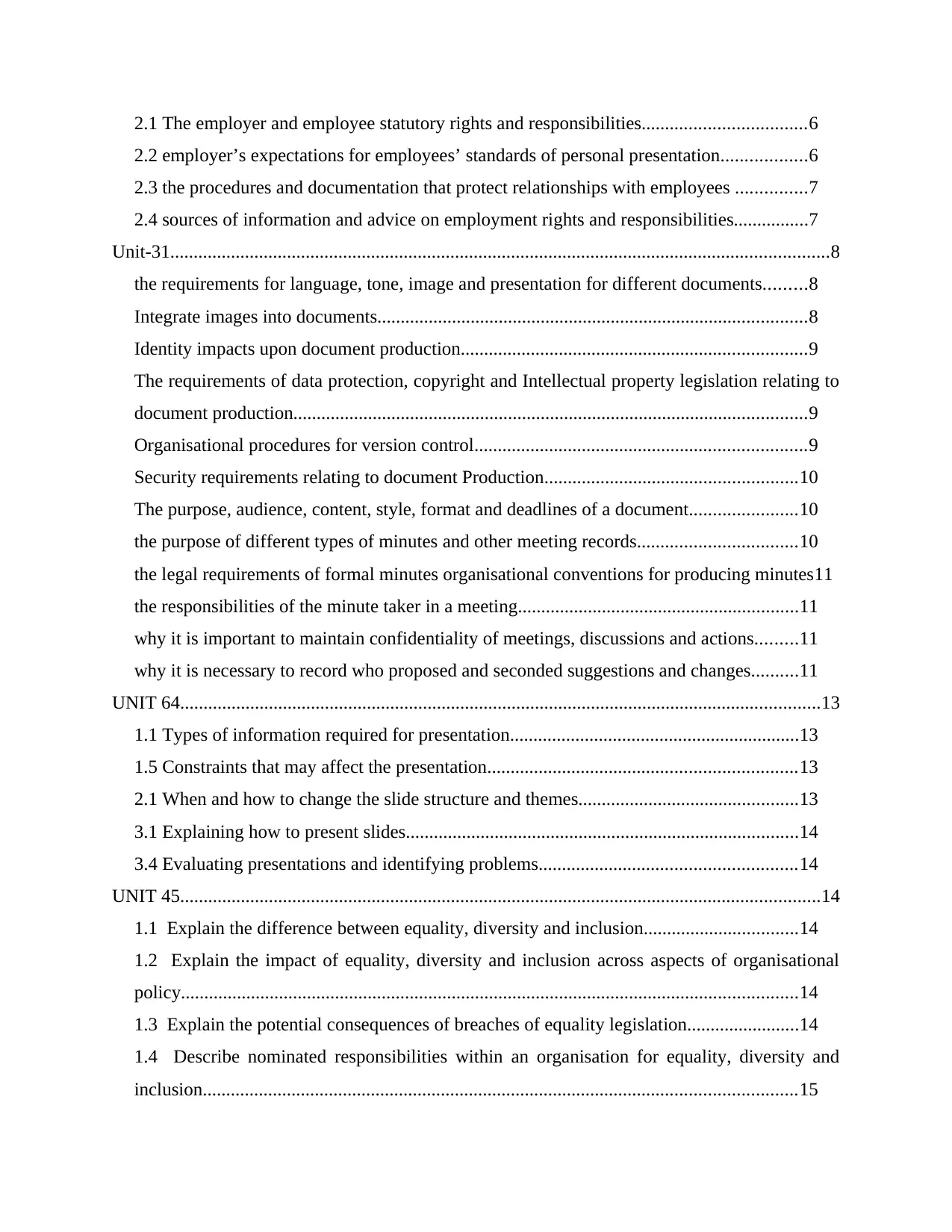
2.1 The employer and employee statutory rights and responsibilities...................................6
2.2 employer’s expectations for employees’ standards of personal presentation..................6
2.3 the procedures and documentation that protect relationships with employees ...............7
2.4 sources of information and advice on employment rights and responsibilities................7
Unit-31.............................................................................................................................................8
the requirements for language, tone, image and presentation for different documents.........8
Integrate images into documents............................................................................................8
Identity impacts upon document production..........................................................................9
The requirements of data protection, copyright and Intellectual property legislation relating to
document production..............................................................................................................9
Organisational procedures for version control.......................................................................9
Security requirements relating to document Production......................................................10
The purpose, audience, content, style, format and deadlines of a document.......................10
the purpose of different types of minutes and other meeting records..................................10
the legal requirements of formal minutes organisational conventions for producing minutes11
the responsibilities of the minute taker in a meeting............................................................11
why it is important to maintain confidentiality of meetings, discussions and actions.........11
why it is necessary to record who proposed and seconded suggestions and changes..........11
UNIT 64.........................................................................................................................................13
1.1 Types of information required for presentation..............................................................13
1.5 Constraints that may affect the presentation..................................................................13
2.1 When and how to change the slide structure and themes...............................................13
3.1 Explaining how to present slides....................................................................................14
3.4 Evaluating presentations and identifying problems.......................................................14
UNIT 45.........................................................................................................................................14
1.1 Explain the difference between equality, diversity and inclusion.................................14
1.2 Explain the impact of equality, diversity and inclusion across aspects of organisational
policy....................................................................................................................................14
1.3 Explain the potential consequences of breaches of equality legislation........................14
1.4 Describe nominated responsibilities within an organisation for equality, diversity and
inclusion...............................................................................................................................15
2.2 employer’s expectations for employees’ standards of personal presentation..................6
2.3 the procedures and documentation that protect relationships with employees ...............7
2.4 sources of information and advice on employment rights and responsibilities................7
Unit-31.............................................................................................................................................8
the requirements for language, tone, image and presentation for different documents.........8
Integrate images into documents............................................................................................8
Identity impacts upon document production..........................................................................9
The requirements of data protection, copyright and Intellectual property legislation relating to
document production..............................................................................................................9
Organisational procedures for version control.......................................................................9
Security requirements relating to document Production......................................................10
The purpose, audience, content, style, format and deadlines of a document.......................10
the purpose of different types of minutes and other meeting records..................................10
the legal requirements of formal minutes organisational conventions for producing minutes11
the responsibilities of the minute taker in a meeting............................................................11
why it is important to maintain confidentiality of meetings, discussions and actions.........11
why it is necessary to record who proposed and seconded suggestions and changes..........11
UNIT 64.........................................................................................................................................13
1.1 Types of information required for presentation..............................................................13
1.5 Constraints that may affect the presentation..................................................................13
2.1 When and how to change the slide structure and themes...............................................13
3.1 Explaining how to present slides....................................................................................14
3.4 Evaluating presentations and identifying problems.......................................................14
UNIT 45.........................................................................................................................................14
1.1 Explain the difference between equality, diversity and inclusion.................................14
1.2 Explain the impact of equality, diversity and inclusion across aspects of organisational
policy....................................................................................................................................14
1.3 Explain the potential consequences of breaches of equality legislation........................14
1.4 Describe nominated responsibilities within an organisation for equality, diversity and
inclusion...............................................................................................................................15
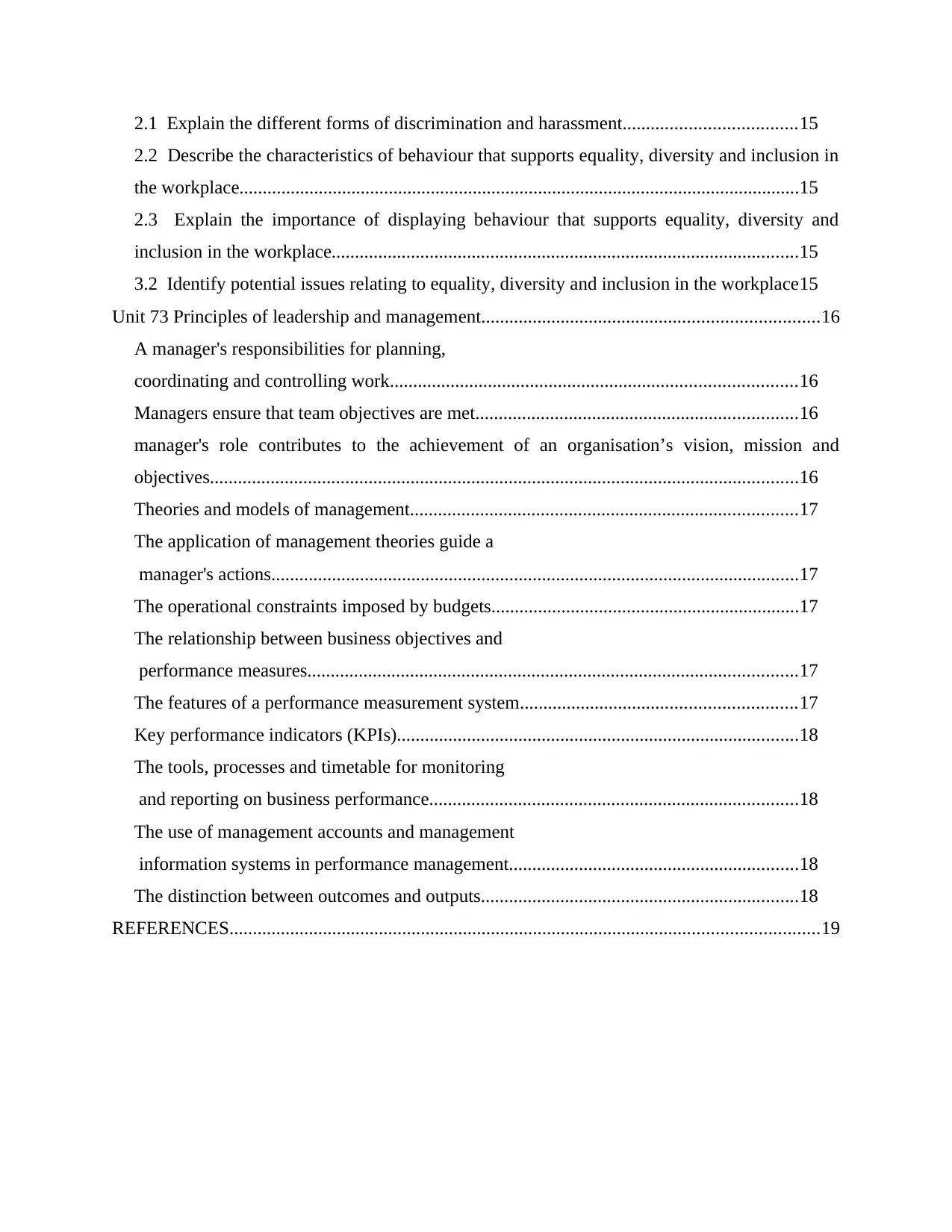
2.1 Explain the different forms of discrimination and harassment.....................................15
2.2 Describe the characteristics of behaviour that supports equality, diversity and inclusion in
the workplace........................................................................................................................15
2.3 Explain the importance of displaying behaviour that supports equality, diversity and
inclusion in the workplace....................................................................................................15
3.2 Identify potential issues relating to equality, diversity and inclusion in the workplace15
Unit 73 Principles of leadership and management........................................................................16
A manager's responsibilities for planning,
coordinating and controlling work.......................................................................................16
Managers ensure that team objectives are met.....................................................................16
manager's role contributes to the achievement of an organisation’s vision, mission and
objectives..............................................................................................................................16
Theories and models of management...................................................................................17
The application of management theories guide a
manager's actions.................................................................................................................17
The operational constraints imposed by budgets..................................................................17
The relationship between business objectives and
performance measures.........................................................................................................17
The features of a performance measurement system...........................................................17
Key performance indicators (KPIs)......................................................................................18
The tools, processes and timetable for monitoring
and reporting on business performance...............................................................................18
The use of management accounts and management
information systems in performance management..............................................................18
The distinction between outcomes and outputs....................................................................18
REFERENCES..............................................................................................................................19
2.2 Describe the characteristics of behaviour that supports equality, diversity and inclusion in
the workplace........................................................................................................................15
2.3 Explain the importance of displaying behaviour that supports equality, diversity and
inclusion in the workplace....................................................................................................15
3.2 Identify potential issues relating to equality, diversity and inclusion in the workplace15
Unit 73 Principles of leadership and management........................................................................16
A manager's responsibilities for planning,
coordinating and controlling work.......................................................................................16
Managers ensure that team objectives are met.....................................................................16
manager's role contributes to the achievement of an organisation’s vision, mission and
objectives..............................................................................................................................16
Theories and models of management...................................................................................17
The application of management theories guide a
manager's actions.................................................................................................................17
The operational constraints imposed by budgets..................................................................17
The relationship between business objectives and
performance measures.........................................................................................................17
The features of a performance measurement system...........................................................17
Key performance indicators (KPIs)......................................................................................18
The tools, processes and timetable for monitoring
and reporting on business performance...............................................................................18
The use of management accounts and management
information systems in performance management..............................................................18
The distinction between outcomes and outputs....................................................................18
REFERENCES..............................................................................................................................19
Secure Best Marks with AI Grader
Need help grading? Try our AI Grader for instant feedback on your assignments.
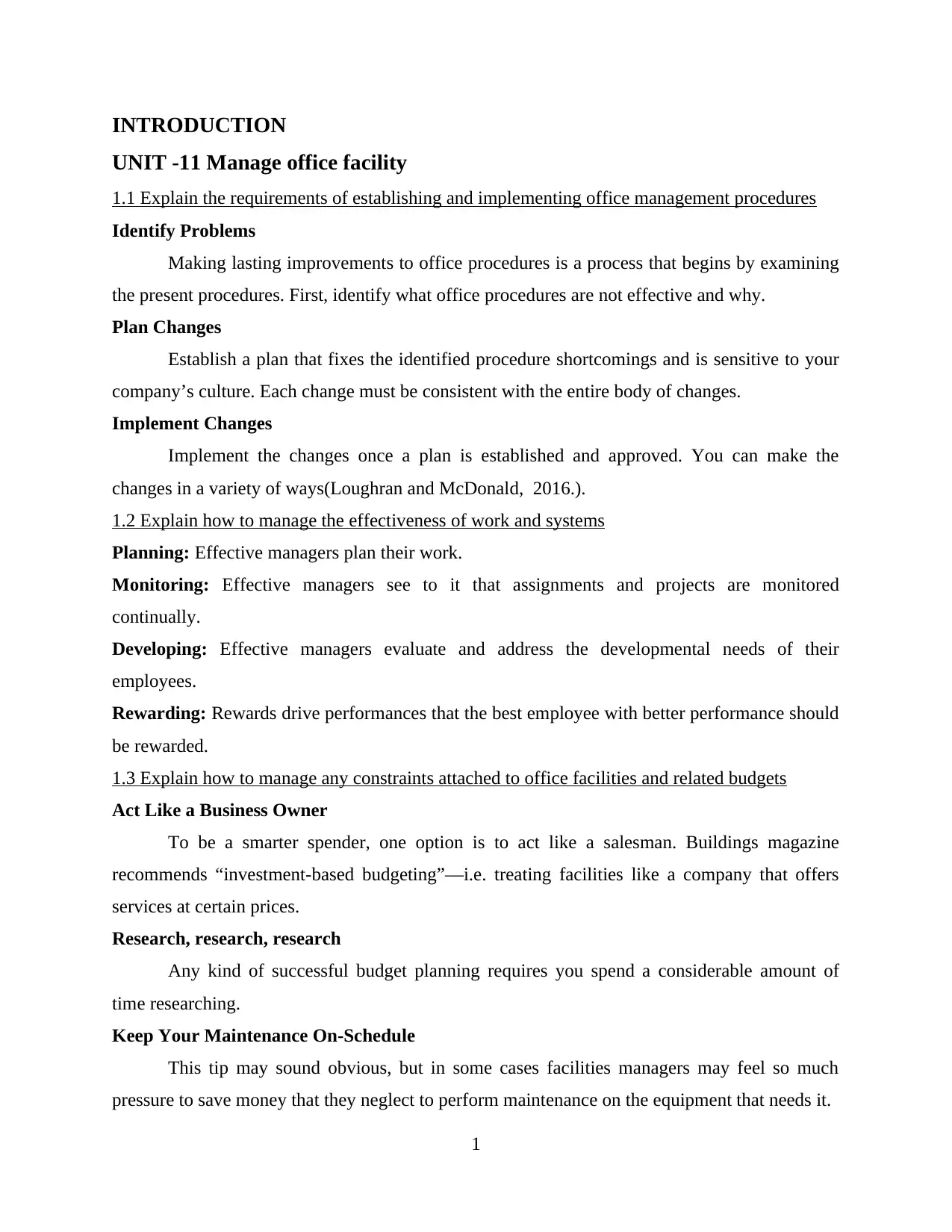
INTRODUCTION
UNIT -11 Manage office facility
1.1 Explain the requirements of establishing and implementing office management procedures
Identify Problems
Making lasting improvements to office procedures is a process that begins by examining
the present procedures. First, identify what office procedures are not effective and why.
Plan Changes
Establish a plan that fixes the identified procedure shortcomings and is sensitive to your
company’s culture. Each change must be consistent with the entire body of changes.
Implement Changes
Implement the changes once a plan is established and approved. You can make the
changes in a variety of ways(Loughran and McDonald, 2016.).
1.2 Explain how to manage the effectiveness of work and systems
Planning: Effective managers plan their work.
Monitoring: Effective managers see to it that assignments and projects are monitored
continually.
Developing: Effective managers evaluate and address the developmental needs of their
employees.
Rewarding: Rewards drive performances that the best employee with better performance should
be rewarded.
1.3 Explain how to manage any constraints attached to office facilities and related budgets
Act Like a Business Owner
To be a smarter spender, one option is to act like a salesman. Buildings magazine
recommends “investment-based budgeting”—i.e. treating facilities like a company that offers
services at certain prices.
Research, research, research
Any kind of successful budget planning requires you spend a considerable amount of
time researching.
Keep Your Maintenance On-Schedule
This tip may sound obvious, but in some cases facilities managers may feel so much
pressure to save money that they neglect to perform maintenance on the equipment that needs it.
1
UNIT -11 Manage office facility
1.1 Explain the requirements of establishing and implementing office management procedures
Identify Problems
Making lasting improvements to office procedures is a process that begins by examining
the present procedures. First, identify what office procedures are not effective and why.
Plan Changes
Establish a plan that fixes the identified procedure shortcomings and is sensitive to your
company’s culture. Each change must be consistent with the entire body of changes.
Implement Changes
Implement the changes once a plan is established and approved. You can make the
changes in a variety of ways(Loughran and McDonald, 2016.).
1.2 Explain how to manage the effectiveness of work and systems
Planning: Effective managers plan their work.
Monitoring: Effective managers see to it that assignments and projects are monitored
continually.
Developing: Effective managers evaluate and address the developmental needs of their
employees.
Rewarding: Rewards drive performances that the best employee with better performance should
be rewarded.
1.3 Explain how to manage any constraints attached to office facilities and related budgets
Act Like a Business Owner
To be a smarter spender, one option is to act like a salesman. Buildings magazine
recommends “investment-based budgeting”—i.e. treating facilities like a company that offers
services at certain prices.
Research, research, research
Any kind of successful budget planning requires you spend a considerable amount of
time researching.
Keep Your Maintenance On-Schedule
This tip may sound obvious, but in some cases facilities managers may feel so much
pressure to save money that they neglect to perform maintenance on the equipment that needs it.
1

1.4 Explain the factors to be taken into account in the design of office systems, procedures and
guidance documents
Management and Delegation
Task plans eliminate confusion about who should be performing a specific duty, work
schedules eliminate the question of what to do next, and planning eliminates the need to work
beyond expected hours with the exception of an emergency situation.
Policies and Procedures
Even if an office is ideally designed, it cannot function to its potential if the people in it do not.
Practice objectives provide overall direction for making decisions, and office policies and
procedures serve as mechanisms for their accomplishment.
1.5 Explain how to create an environment that is conducive to productive work
Hire an Adequate Workforce
It’s important to engage in workforce forecasting so that you have enough people to
satisfy your existing workload.
Set Realistic Expectations
If you want to get the best work from your employees, then you have to make your
expectations clear and realistic.
Offer Fair Compensation
Proper labour management services require you to pay attention to your bottom line.
UNIT-19 Handle Mail
1.1 Explain how to deal with “junk” mail
Enable junk mail filtering: At the top of this preference, you see that you can turn it on or off
with a single click.
When junk mail arrives: By default, messages deemed to be junk will be left in your inbox but
marked in an orange brown colour, making it easy to spy them in your message list.
Filter junk mail before applying rules: This option, which is off by default, gives junk mail
filtering priority when your mail is filtered.
Reset button: If you’ve failed to train Mail or done it so rarely that you get bizarre results, it
may be time to start over and commit to doing it right the next time(Neal‐Boylan. and Miller,
2015).
2
guidance documents
Management and Delegation
Task plans eliminate confusion about who should be performing a specific duty, work
schedules eliminate the question of what to do next, and planning eliminates the need to work
beyond expected hours with the exception of an emergency situation.
Policies and Procedures
Even if an office is ideally designed, it cannot function to its potential if the people in it do not.
Practice objectives provide overall direction for making decisions, and office policies and
procedures serve as mechanisms for their accomplishment.
1.5 Explain how to create an environment that is conducive to productive work
Hire an Adequate Workforce
It’s important to engage in workforce forecasting so that you have enough people to
satisfy your existing workload.
Set Realistic Expectations
If you want to get the best work from your employees, then you have to make your
expectations clear and realistic.
Offer Fair Compensation
Proper labour management services require you to pay attention to your bottom line.
UNIT-19 Handle Mail
1.1 Explain how to deal with “junk” mail
Enable junk mail filtering: At the top of this preference, you see that you can turn it on or off
with a single click.
When junk mail arrives: By default, messages deemed to be junk will be left in your inbox but
marked in an orange brown colour, making it easy to spy them in your message list.
Filter junk mail before applying rules: This option, which is off by default, gives junk mail
filtering priority when your mail is filtered.
Reset button: If you’ve failed to train Mail or done it so rarely that you get bizarre results, it
may be time to start over and commit to doing it right the next time(Neal‐Boylan. and Miller,
2015).
2
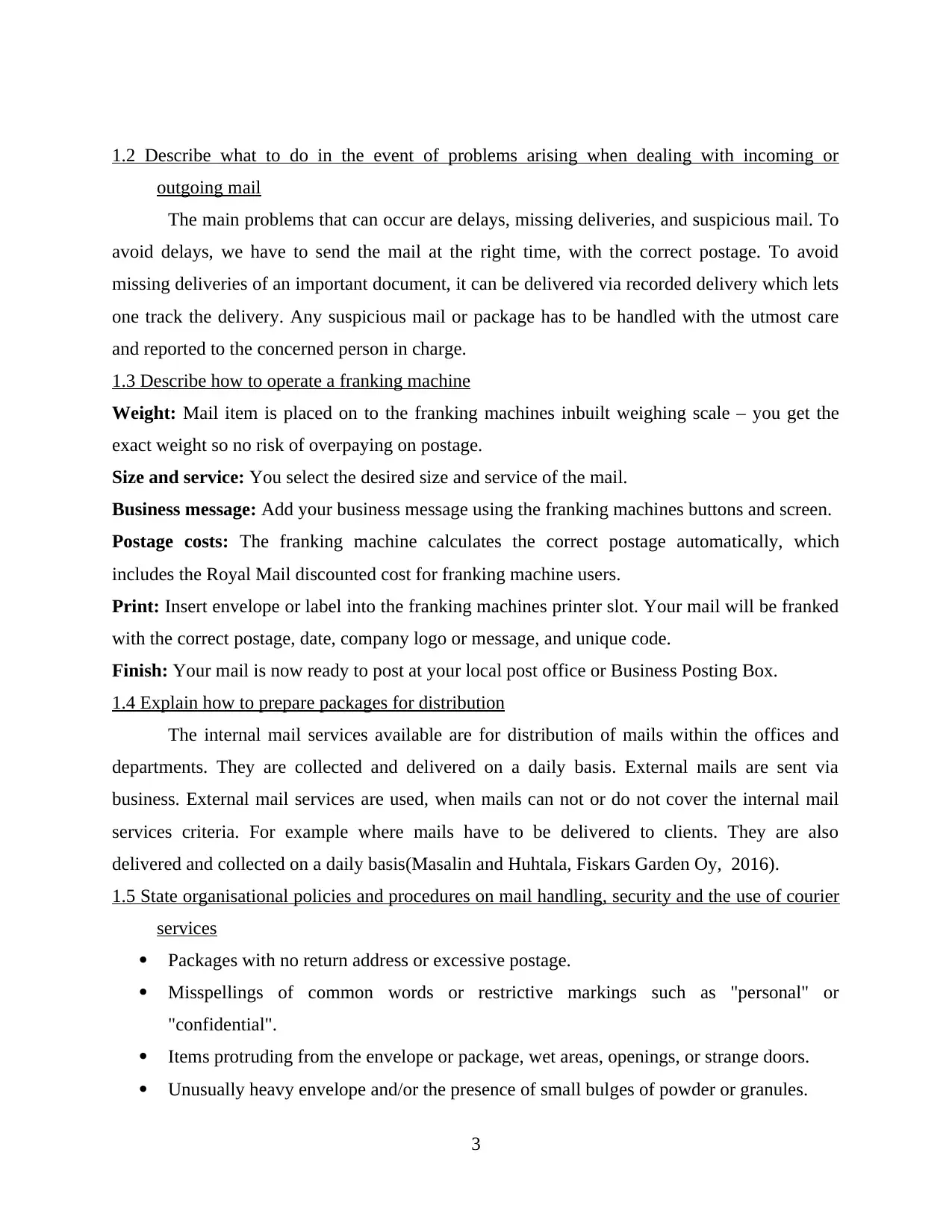
1.2 Describe what to do in the event of problems arising when dealing with incoming or
outgoing mail
The main problems that can occur are delays, missing deliveries, and suspicious mail. To
avoid delays, we have to send the mail at the right time, with the correct postage. To avoid
missing deliveries of an important document, it can be delivered via recorded delivery which lets
one track the delivery. Any suspicious mail or package has to be handled with the utmost care
and reported to the concerned person in charge.
1.3 Describe how to operate a franking machine
Weight: Mail item is placed on to the franking machines inbuilt weighing scale – you get the
exact weight so no risk of overpaying on postage.
Size and service: You select the desired size and service of the mail.
Business message: Add your business message using the franking machines buttons and screen.
Postage costs: The franking machine calculates the correct postage automatically, which
includes the Royal Mail discounted cost for franking machine users.
Print: Insert envelope or label into the franking machines printer slot. Your mail will be franked
with the correct postage, date, company logo or message, and unique code.
Finish: Your mail is now ready to post at your local post office or Business Posting Box.
1.4 Explain how to prepare packages for distribution
The internal mail services available are for distribution of mails within the offices and
departments. They are collected and delivered on a daily basis. External mails are sent via
business. External mail services are used, when mails can not or do not cover the internal mail
services criteria. For example where mails have to be delivered to clients. They are also
delivered and collected on a daily basis(Masalin and Huhtala, Fiskars Garden Oy, 2016).
1.5 State organisational policies and procedures on mail handling, security and the use of courier
services
Packages with no return address or excessive postage.
Misspellings of common words or restrictive markings such as "personal" or
"confidential".
Items protruding from the envelope or package, wet areas, openings, or strange doors.
Unusually heavy envelope and/or the presence of small bulges of powder or granules.
3
outgoing mail
The main problems that can occur are delays, missing deliveries, and suspicious mail. To
avoid delays, we have to send the mail at the right time, with the correct postage. To avoid
missing deliveries of an important document, it can be delivered via recorded delivery which lets
one track the delivery. Any suspicious mail or package has to be handled with the utmost care
and reported to the concerned person in charge.
1.3 Describe how to operate a franking machine
Weight: Mail item is placed on to the franking machines inbuilt weighing scale – you get the
exact weight so no risk of overpaying on postage.
Size and service: You select the desired size and service of the mail.
Business message: Add your business message using the franking machines buttons and screen.
Postage costs: The franking machine calculates the correct postage automatically, which
includes the Royal Mail discounted cost for franking machine users.
Print: Insert envelope or label into the franking machines printer slot. Your mail will be franked
with the correct postage, date, company logo or message, and unique code.
Finish: Your mail is now ready to post at your local post office or Business Posting Box.
1.4 Explain how to prepare packages for distribution
The internal mail services available are for distribution of mails within the offices and
departments. They are collected and delivered on a daily basis. External mails are sent via
business. External mail services are used, when mails can not or do not cover the internal mail
services criteria. For example where mails have to be delivered to clients. They are also
delivered and collected on a daily basis(Masalin and Huhtala, Fiskars Garden Oy, 2016).
1.5 State organisational policies and procedures on mail handling, security and the use of courier
services
Packages with no return address or excessive postage.
Misspellings of common words or restrictive markings such as "personal" or
"confidential".
Items protruding from the envelope or package, wet areas, openings, or strange doors.
Unusually heavy envelope and/or the presence of small bulges of powder or granules.
3
Paraphrase This Document
Need a fresh take? Get an instant paraphrase of this document with our AI Paraphraser
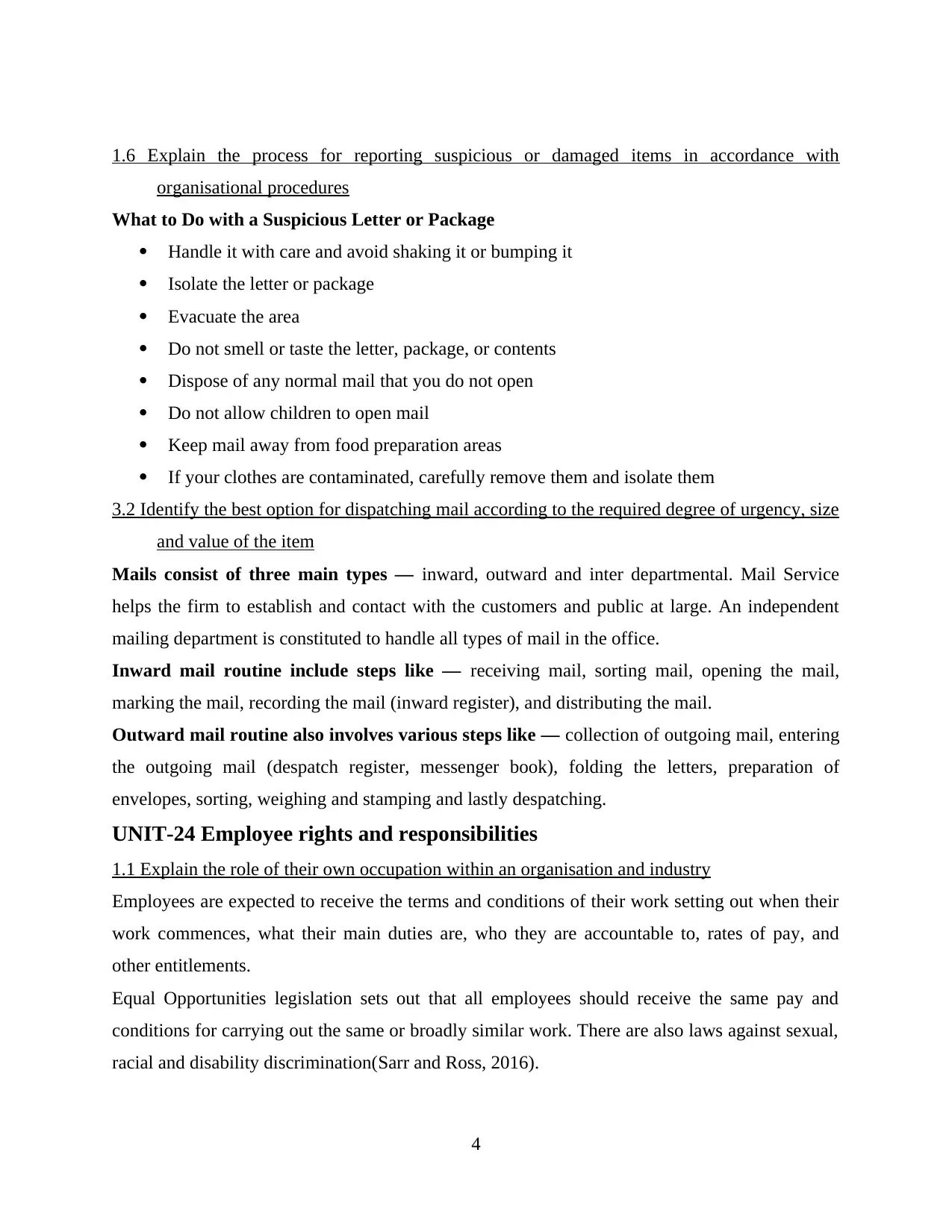
1.6 Explain the process for reporting suspicious or damaged items in accordance with
organisational procedures
What to Do with a Suspicious Letter or Package
Handle it with care and avoid shaking it or bumping it
Isolate the letter or package
Evacuate the area
Do not smell or taste the letter, package, or contents
Dispose of any normal mail that you do not open
Do not allow children to open mail
Keep mail away from food preparation areas
If your clothes are contaminated, carefully remove them and isolate them
3.2 Identify the best option for dispatching mail according to the required degree of urgency, size
and value of the item
Mails consist of three main types — inward, outward and inter departmental. Mail Service
helps the firm to establish and contact with the customers and public at large. An independent
mailing department is constituted to handle all types of mail in the office.
Inward mail routine include steps like — receiving mail, sorting mail, opening the mail,
marking the mail, recording the mail (inward register), and distributing the mail.
Outward mail routine also involves various steps like — collection of outgoing mail, entering
the outgoing mail (despatch register, messenger book), folding the letters, preparation of
envelopes, sorting, weighing and stamping and lastly despatching.
UNIT-24 Employee rights and responsibilities
1.1 Explain the role of their own occupation within an organisation and industry
Employees are expected to receive the terms and conditions of their work setting out when their
work commences, what their main duties are, who they are accountable to, rates of pay, and
other entitlements.
Equal Opportunities legislation sets out that all employees should receive the same pay and
conditions for carrying out the same or broadly similar work. There are also laws against sexual,
racial and disability discrimination(Sarr and Ross, 2016).
4
organisational procedures
What to Do with a Suspicious Letter or Package
Handle it with care and avoid shaking it or bumping it
Isolate the letter or package
Evacuate the area
Do not smell or taste the letter, package, or contents
Dispose of any normal mail that you do not open
Do not allow children to open mail
Keep mail away from food preparation areas
If your clothes are contaminated, carefully remove them and isolate them
3.2 Identify the best option for dispatching mail according to the required degree of urgency, size
and value of the item
Mails consist of three main types — inward, outward and inter departmental. Mail Service
helps the firm to establish and contact with the customers and public at large. An independent
mailing department is constituted to handle all types of mail in the office.
Inward mail routine include steps like — receiving mail, sorting mail, opening the mail,
marking the mail, recording the mail (inward register), and distributing the mail.
Outward mail routine also involves various steps like — collection of outgoing mail, entering
the outgoing mail (despatch register, messenger book), folding the letters, preparation of
envelopes, sorting, weighing and stamping and lastly despatching.
UNIT-24 Employee rights and responsibilities
1.1 Explain the role of their own occupation within an organisation and industry
Employees are expected to receive the terms and conditions of their work setting out when their
work commences, what their main duties are, who they are accountable to, rates of pay, and
other entitlements.
Equal Opportunities legislation sets out that all employees should receive the same pay and
conditions for carrying out the same or broadly similar work. There are also laws against sexual,
racial and disability discrimination(Sarr and Ross, 2016).
4
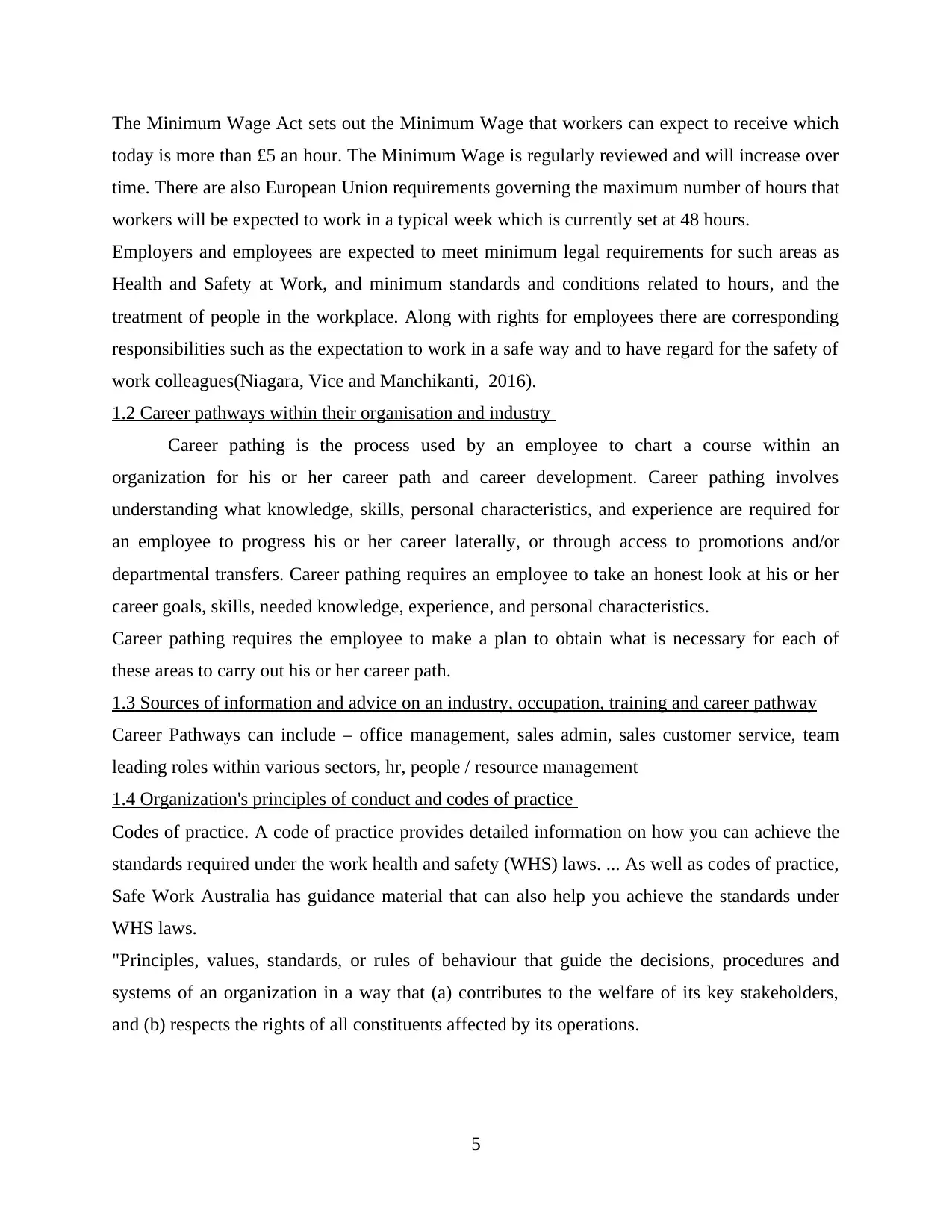
The Minimum Wage Act sets out the Minimum Wage that workers can expect to receive which
today is more than £5 an hour. The Minimum Wage is regularly reviewed and will increase over
time. There are also European Union requirements governing the maximum number of hours that
workers will be expected to work in a typical week which is currently set at 48 hours.
Employers and employees are expected to meet minimum legal requirements for such areas as
Health and Safety at Work, and minimum standards and conditions related to hours, and the
treatment of people in the workplace. Along with rights for employees there are corresponding
responsibilities such as the expectation to work in a safe way and to have regard for the safety of
work colleagues(Niagara, Vice and Manchikanti, 2016).
1.2 Career pathways within their organisation and industry
Career pathing is the process used by an employee to chart a course within an
organization for his or her career path and career development. Career pathing involves
understanding what knowledge, skills, personal characteristics, and experience are required for
an employee to progress his or her career laterally, or through access to promotions and/or
departmental transfers. Career pathing requires an employee to take an honest look at his or her
career goals, skills, needed knowledge, experience, and personal characteristics.
Career pathing requires the employee to make a plan to obtain what is necessary for each of
these areas to carry out his or her career path.
1.3 Sources of information and advice on an industry, occupation, training and career pathway
Career Pathways can include – office management, sales admin, sales customer service, team
leading roles within various sectors, hr, people / resource management
1.4 Organization's principles of conduct and codes of practice
Codes of practice. A code of practice provides detailed information on how you can achieve the
standards required under the work health and safety (WHS) laws. ... As well as codes of practice,
Safe Work Australia has guidance material that can also help you achieve the standards under
WHS laws.
"Principles, values, standards, or rules of behaviour that guide the decisions, procedures and
systems of an organization in a way that (a) contributes to the welfare of its key stakeholders,
and (b) respects the rights of all constituents affected by its operations.
5
today is more than £5 an hour. The Minimum Wage is regularly reviewed and will increase over
time. There are also European Union requirements governing the maximum number of hours that
workers will be expected to work in a typical week which is currently set at 48 hours.
Employers and employees are expected to meet minimum legal requirements for such areas as
Health and Safety at Work, and minimum standards and conditions related to hours, and the
treatment of people in the workplace. Along with rights for employees there are corresponding
responsibilities such as the expectation to work in a safe way and to have regard for the safety of
work colleagues(Niagara, Vice and Manchikanti, 2016).
1.2 Career pathways within their organisation and industry
Career pathing is the process used by an employee to chart a course within an
organization for his or her career path and career development. Career pathing involves
understanding what knowledge, skills, personal characteristics, and experience are required for
an employee to progress his or her career laterally, or through access to promotions and/or
departmental transfers. Career pathing requires an employee to take an honest look at his or her
career goals, skills, needed knowledge, experience, and personal characteristics.
Career pathing requires the employee to make a plan to obtain what is necessary for each of
these areas to carry out his or her career path.
1.3 Sources of information and advice on an industry, occupation, training and career pathway
Career Pathways can include – office management, sales admin, sales customer service, team
leading roles within various sectors, hr, people / resource management
1.4 Organization's principles of conduct and codes of practice
Codes of practice. A code of practice provides detailed information on how you can achieve the
standards required under the work health and safety (WHS) laws. ... As well as codes of practice,
Safe Work Australia has guidance material that can also help you achieve the standards under
WHS laws.
"Principles, values, standards, or rules of behaviour that guide the decisions, procedures and
systems of an organization in a way that (a) contributes to the welfare of its key stakeholders,
and (b) respects the rights of all constituents affected by its operations.
5
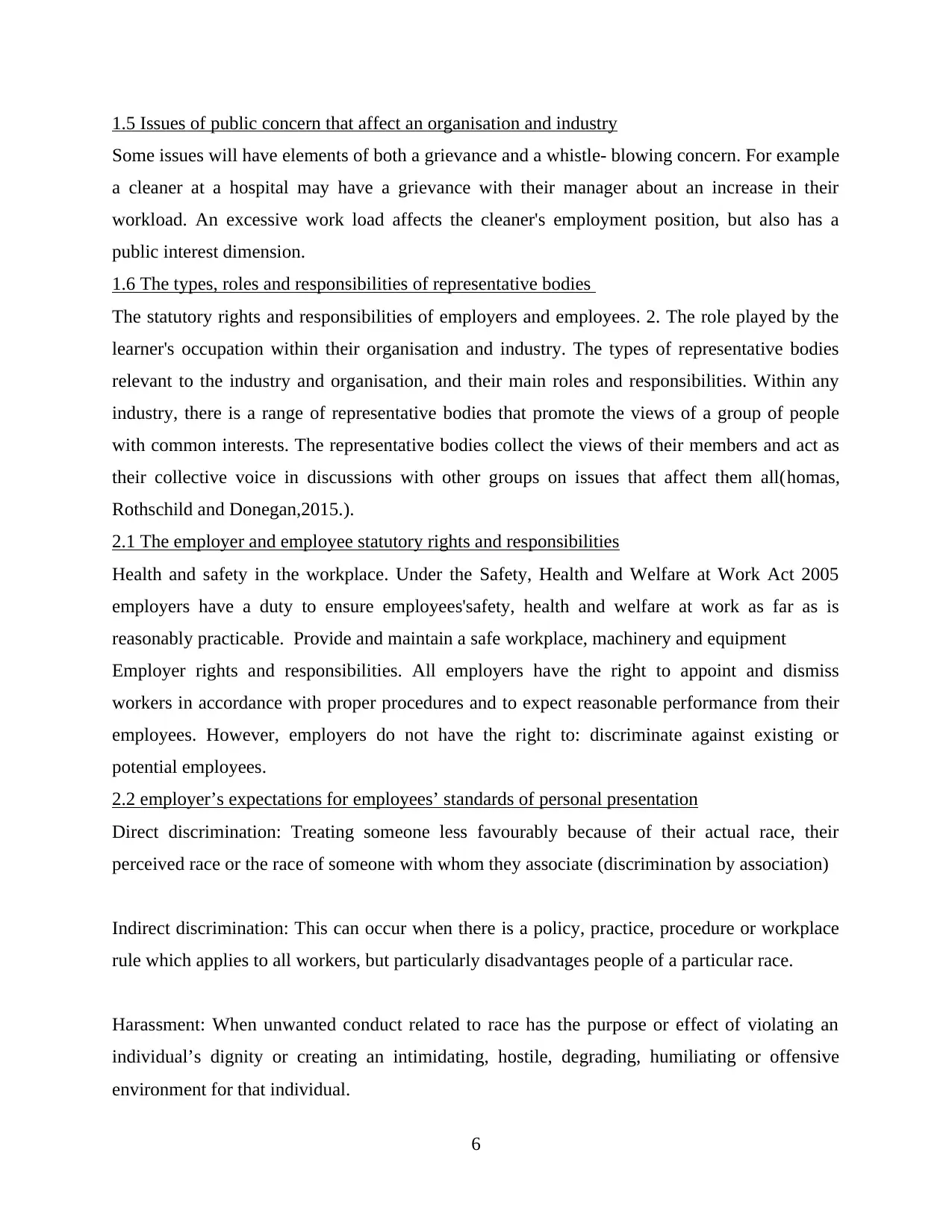
1.5 Issues of public concern that affect an organisation and industry
Some issues will have elements of both a grievance and a whistle- blowing concern. For example
a cleaner at a hospital may have a grievance with their manager about an increase in their
workload. An excessive work load affects the cleaner's employment position, but also has a
public interest dimension.
1.6 The types, roles and responsibilities of representative bodies
The statutory rights and responsibilities of employers and employees. 2. The role played by the
learner's occupation within their organisation and industry. The types of representative bodies
relevant to the industry and organisation, and their main roles and responsibilities. Within any
industry, there is a range of representative bodies that promote the views of a group of people
with common interests. The representative bodies collect the views of their members and act as
their collective voice in discussions with other groups on issues that affect them all(homas,
Rothschild and Donegan,2015.).
2.1 The employer and employee statutory rights and responsibilities
Health and safety in the workplace. Under the Safety, Health and Welfare at Work Act 2005
employers have a duty to ensure employees'safety, health and welfare at work as far as is
reasonably practicable. Provide and maintain a safe workplace, machinery and equipment
Employer rights and responsibilities. All employers have the right to appoint and dismiss
workers in accordance with proper procedures and to expect reasonable performance from their
employees. However, employers do not have the right to: discriminate against existing or
potential employees.
2.2 employer’s expectations for employees’ standards of personal presentation
Direct discrimination: Treating someone less favourably because of their actual race, their
perceived race or the race of someone with whom they associate (discrimination by association)
Indirect discrimination: This can occur when there is a policy, practice, procedure or workplace
rule which applies to all workers, but particularly disadvantages people of a particular race.
Harassment: When unwanted conduct related to race has the purpose or effect of violating an
individual’s dignity or creating an intimidating, hostile, degrading, humiliating or offensive
environment for that individual.
6
Some issues will have elements of both a grievance and a whistle- blowing concern. For example
a cleaner at a hospital may have a grievance with their manager about an increase in their
workload. An excessive work load affects the cleaner's employment position, but also has a
public interest dimension.
1.6 The types, roles and responsibilities of representative bodies
The statutory rights and responsibilities of employers and employees. 2. The role played by the
learner's occupation within their organisation and industry. The types of representative bodies
relevant to the industry and organisation, and their main roles and responsibilities. Within any
industry, there is a range of representative bodies that promote the views of a group of people
with common interests. The representative bodies collect the views of their members and act as
their collective voice in discussions with other groups on issues that affect them all(homas,
Rothschild and Donegan,2015.).
2.1 The employer and employee statutory rights and responsibilities
Health and safety in the workplace. Under the Safety, Health and Welfare at Work Act 2005
employers have a duty to ensure employees'safety, health and welfare at work as far as is
reasonably practicable. Provide and maintain a safe workplace, machinery and equipment
Employer rights and responsibilities. All employers have the right to appoint and dismiss
workers in accordance with proper procedures and to expect reasonable performance from their
employees. However, employers do not have the right to: discriminate against existing or
potential employees.
2.2 employer’s expectations for employees’ standards of personal presentation
Direct discrimination: Treating someone less favourably because of their actual race, their
perceived race or the race of someone with whom they associate (discrimination by association)
Indirect discrimination: This can occur when there is a policy, practice, procedure or workplace
rule which applies to all workers, but particularly disadvantages people of a particular race.
Harassment: When unwanted conduct related to race has the purpose or effect of violating an
individual’s dignity or creating an intimidating, hostile, degrading, humiliating or offensive
environment for that individual.
6
Secure Best Marks with AI Grader
Need help grading? Try our AI Grader for instant feedback on your assignments.
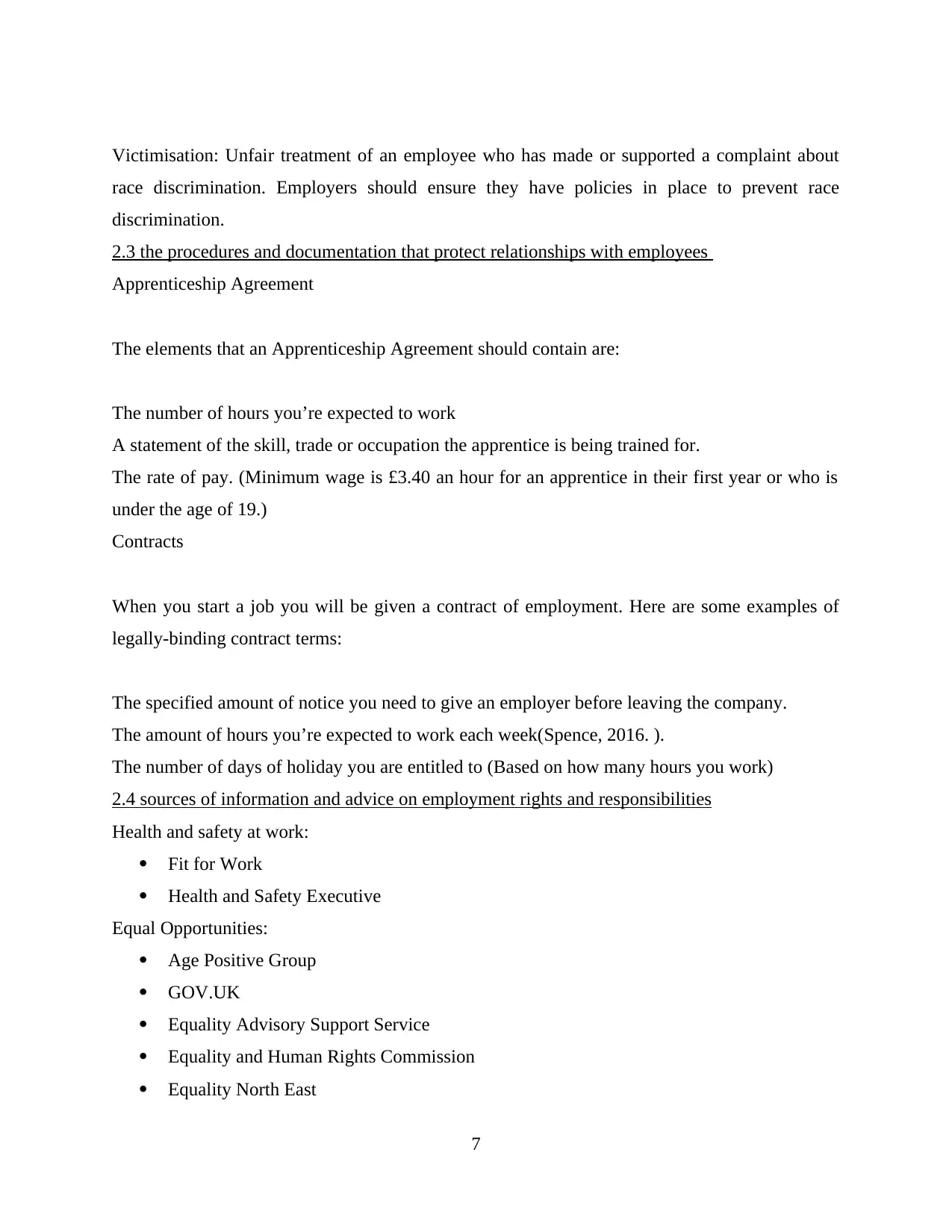
Victimisation: Unfair treatment of an employee who has made or supported a complaint about
race discrimination. Employers should ensure they have policies in place to prevent race
discrimination.
2.3 the procedures and documentation that protect relationships with employees
Apprenticeship Agreement
The elements that an Apprenticeship Agreement should contain are:
The number of hours you’re expected to work
A statement of the skill, trade or occupation the apprentice is being trained for.
The rate of pay. (Minimum wage is £3.40 an hour for an apprentice in their first year or who is
under the age of 19.)
Contracts
When you start a job you will be given a contract of employment. Here are some examples of
legally-binding contract terms:
The specified amount of notice you need to give an employer before leaving the company.
The amount of hours you’re expected to work each week(Spence, 2016. ).
The number of days of holiday you are entitled to (Based on how many hours you work)
2.4 sources of information and advice on employment rights and responsibilities
Health and safety at work:
Fit for Work
Health and Safety Executive
Equal Opportunities:
Age Positive Group
GOV.UK
Equality Advisory Support Service
Equality and Human Rights Commission
Equality North East
7
race discrimination. Employers should ensure they have policies in place to prevent race
discrimination.
2.3 the procedures and documentation that protect relationships with employees
Apprenticeship Agreement
The elements that an Apprenticeship Agreement should contain are:
The number of hours you’re expected to work
A statement of the skill, trade or occupation the apprentice is being trained for.
The rate of pay. (Minimum wage is £3.40 an hour for an apprentice in their first year or who is
under the age of 19.)
Contracts
When you start a job you will be given a contract of employment. Here are some examples of
legally-binding contract terms:
The specified amount of notice you need to give an employer before leaving the company.
The amount of hours you’re expected to work each week(Spence, 2016. ).
The number of days of holiday you are entitled to (Based on how many hours you work)
2.4 sources of information and advice on employment rights and responsibilities
Health and safety at work:
Fit for Work
Health and Safety Executive
Equal Opportunities:
Age Positive Group
GOV.UK
Equality Advisory Support Service
Equality and Human Rights Commission
Equality North East
7
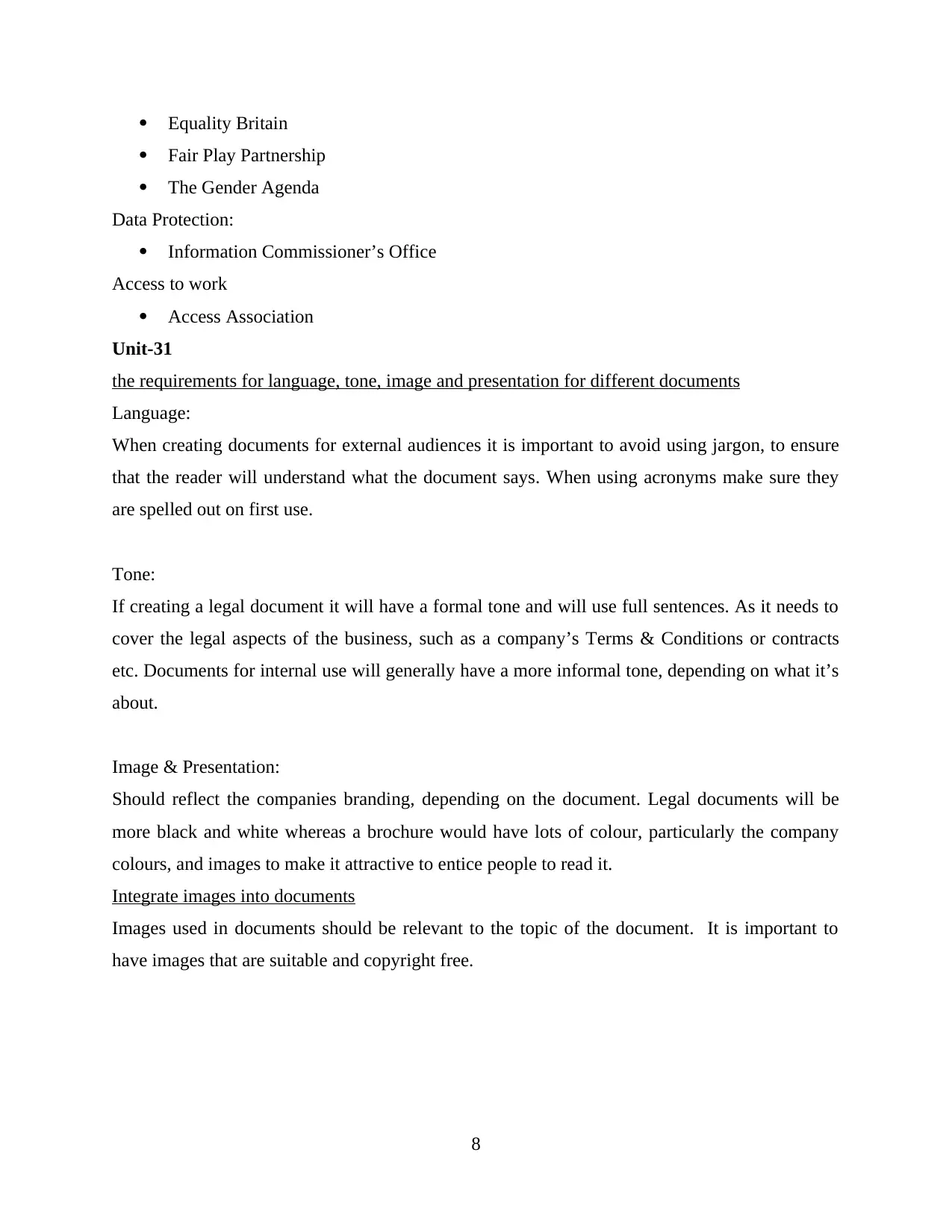
Equality Britain
Fair Play Partnership
The Gender Agenda
Data Protection:
Information Commissioner’s Office
Access to work
Access Association
Unit-31
the requirements for language, tone, image and presentation for different documents
Language:
When creating documents for external audiences it is important to avoid using jargon, to ensure
that the reader will understand what the document says. When using acronyms make sure they
are spelled out on first use.
Tone:
If creating a legal document it will have a formal tone and will use full sentences. As it needs to
cover the legal aspects of the business, such as a company’s Terms & Conditions or contracts
etc. Documents for internal use will generally have a more informal tone, depending on what it’s
about.
Image & Presentation:
Should reflect the companies branding, depending on the document. Legal documents will be
more black and white whereas a brochure would have lots of colour, particularly the company
colours, and images to make it attractive to entice people to read it.
Integrate images into documents
Images used in documents should be relevant to the topic of the document. It is important to
have images that are suitable and copyright free.
8
Fair Play Partnership
The Gender Agenda
Data Protection:
Information Commissioner’s Office
Access to work
Access Association
Unit-31
the requirements for language, tone, image and presentation for different documents
Language:
When creating documents for external audiences it is important to avoid using jargon, to ensure
that the reader will understand what the document says. When using acronyms make sure they
are spelled out on first use.
Tone:
If creating a legal document it will have a formal tone and will use full sentences. As it needs to
cover the legal aspects of the business, such as a company’s Terms & Conditions or contracts
etc. Documents for internal use will generally have a more informal tone, depending on what it’s
about.
Image & Presentation:
Should reflect the companies branding, depending on the document. Legal documents will be
more black and white whereas a brochure would have lots of colour, particularly the company
colours, and images to make it attractive to entice people to read it.
Integrate images into documents
Images used in documents should be relevant to the topic of the document. It is important to
have images that are suitable and copyright free.
8
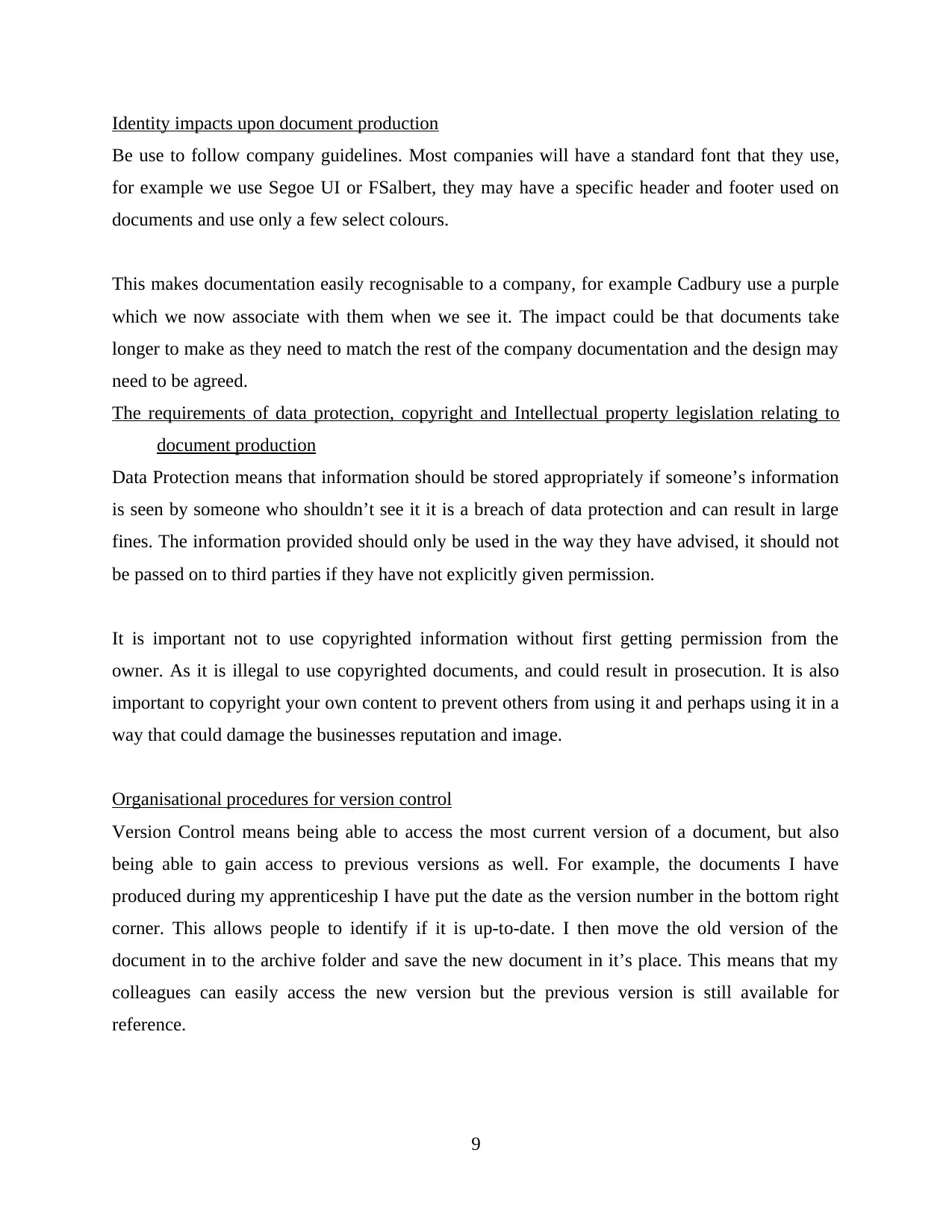
Identity impacts upon document production
Be use to follow company guidelines. Most companies will have a standard font that they use,
for example we use Segoe UI or FSalbert, they may have a specific header and footer used on
documents and use only a few select colours.
This makes documentation easily recognisable to a company, for example Cadbury use a purple
which we now associate with them when we see it. The impact could be that documents take
longer to make as they need to match the rest of the company documentation and the design may
need to be agreed.
The requirements of data protection, copyright and Intellectual property legislation relating to
document production
Data Protection means that information should be stored appropriately if someone’s information
is seen by someone who shouldn’t see it it is a breach of data protection and can result in large
fines. The information provided should only be used in the way they have advised, it should not
be passed on to third parties if they have not explicitly given permission.
It is important not to use copyrighted information without first getting permission from the
owner. As it is illegal to use copyrighted documents, and could result in prosecution. It is also
important to copyright your own content to prevent others from using it and perhaps using it in a
way that could damage the businesses reputation and image.
Organisational procedures for version control
Version Control means being able to access the most current version of a document, but also
being able to gain access to previous versions as well. For example, the documents I have
produced during my apprenticeship I have put the date as the version number in the bottom right
corner. This allows people to identify if it is up-to-date. I then move the old version of the
document in to the archive folder and save the new document in it’s place. This means that my
colleagues can easily access the new version but the previous version is still available for
reference.
9
Be use to follow company guidelines. Most companies will have a standard font that they use,
for example we use Segoe UI or FSalbert, they may have a specific header and footer used on
documents and use only a few select colours.
This makes documentation easily recognisable to a company, for example Cadbury use a purple
which we now associate with them when we see it. The impact could be that documents take
longer to make as they need to match the rest of the company documentation and the design may
need to be agreed.
The requirements of data protection, copyright and Intellectual property legislation relating to
document production
Data Protection means that information should be stored appropriately if someone’s information
is seen by someone who shouldn’t see it it is a breach of data protection and can result in large
fines. The information provided should only be used in the way they have advised, it should not
be passed on to third parties if they have not explicitly given permission.
It is important not to use copyrighted information without first getting permission from the
owner. As it is illegal to use copyrighted documents, and could result in prosecution. It is also
important to copyright your own content to prevent others from using it and perhaps using it in a
way that could damage the businesses reputation and image.
Organisational procedures for version control
Version Control means being able to access the most current version of a document, but also
being able to gain access to previous versions as well. For example, the documents I have
produced during my apprenticeship I have put the date as the version number in the bottom right
corner. This allows people to identify if it is up-to-date. I then move the old version of the
document in to the archive folder and save the new document in it’s place. This means that my
colleagues can easily access the new version but the previous version is still available for
reference.
9
Paraphrase This Document
Need a fresh take? Get an instant paraphrase of this document with our AI Paraphraser
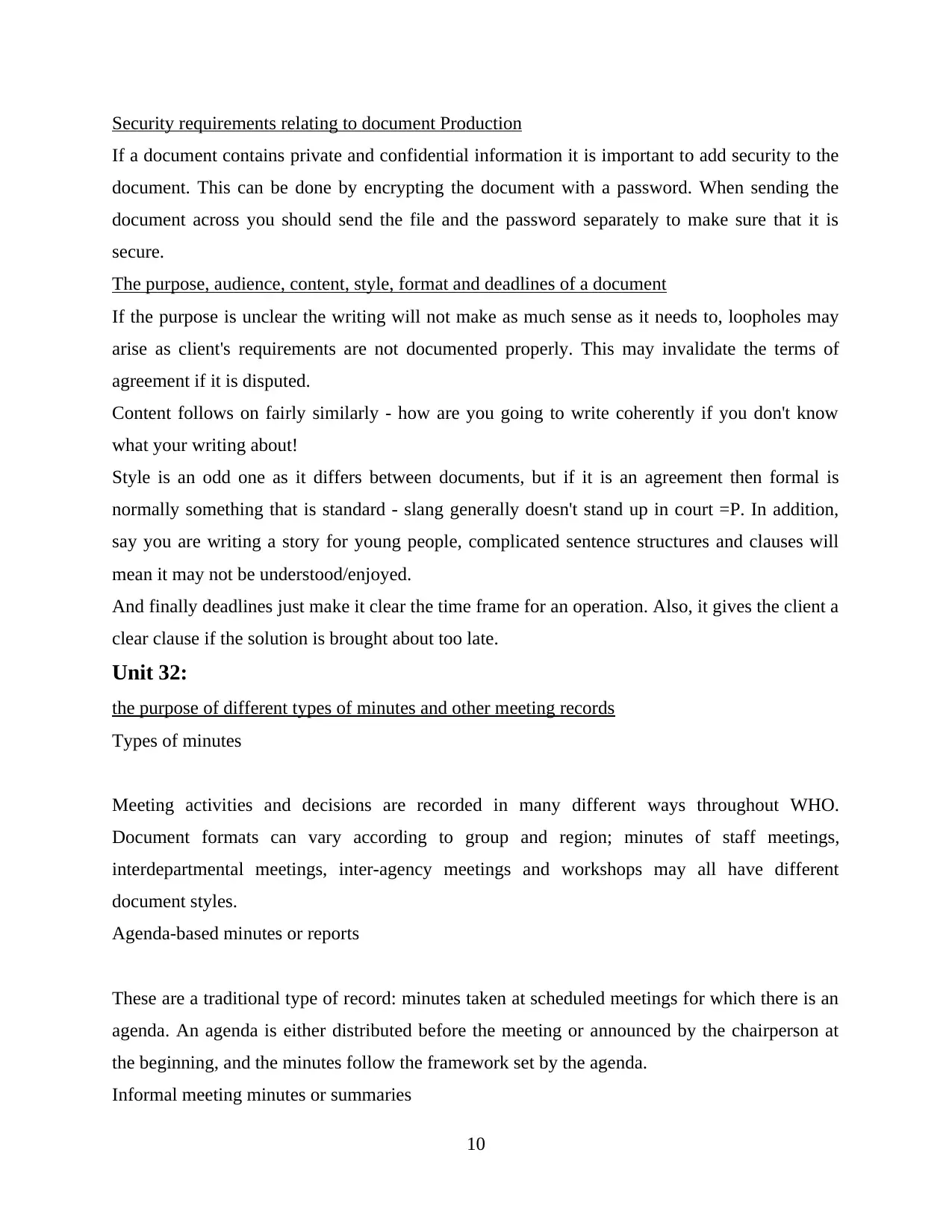
Security requirements relating to document Production
If a document contains private and confidential information it is important to add security to the
document. This can be done by encrypting the document with a password. When sending the
document across you should send the file and the password separately to make sure that it is
secure.
The purpose, audience, content, style, format and deadlines of a document
If the purpose is unclear the writing will not make as much sense as it needs to, loopholes may
arise as client's requirements are not documented properly. This may invalidate the terms of
agreement if it is disputed.
Content follows on fairly similarly - how are you going to write coherently if you don't know
what your writing about!
Style is an odd one as it differs between documents, but if it is an agreement then formal is
normally something that is standard - slang generally doesn't stand up in court =P. In addition,
say you are writing a story for young people, complicated sentence structures and clauses will
mean it may not be understood/enjoyed.
And finally deadlines just make it clear the time frame for an operation. Also, it gives the client a
clear clause if the solution is brought about too late.
Unit 32:
the purpose of different types of minutes and other meeting records
Types of minutes
Meeting activities and decisions are recorded in many different ways throughout WHO.
Document formats can vary according to group and region; minutes of staff meetings,
interdepartmental meetings, inter-agency meetings and workshops may all have different
document styles.
Agenda-based minutes or reports
These are a traditional type of record: minutes taken at scheduled meetings for which there is an
agenda. An agenda is either distributed before the meeting or announced by the chairperson at
the beginning, and the minutes follow the framework set by the agenda.
Informal meeting minutes or summaries
10
If a document contains private and confidential information it is important to add security to the
document. This can be done by encrypting the document with a password. When sending the
document across you should send the file and the password separately to make sure that it is
secure.
The purpose, audience, content, style, format and deadlines of a document
If the purpose is unclear the writing will not make as much sense as it needs to, loopholes may
arise as client's requirements are not documented properly. This may invalidate the terms of
agreement if it is disputed.
Content follows on fairly similarly - how are you going to write coherently if you don't know
what your writing about!
Style is an odd one as it differs between documents, but if it is an agreement then formal is
normally something that is standard - slang generally doesn't stand up in court =P. In addition,
say you are writing a story for young people, complicated sentence structures and clauses will
mean it may not be understood/enjoyed.
And finally deadlines just make it clear the time frame for an operation. Also, it gives the client a
clear clause if the solution is brought about too late.
Unit 32:
the purpose of different types of minutes and other meeting records
Types of minutes
Meeting activities and decisions are recorded in many different ways throughout WHO.
Document formats can vary according to group and region; minutes of staff meetings,
interdepartmental meetings, inter-agency meetings and workshops may all have different
document styles.
Agenda-based minutes or reports
These are a traditional type of record: minutes taken at scheduled meetings for which there is an
agenda. An agenda is either distributed before the meeting or announced by the chairperson at
the beginning, and the minutes follow the framework set by the agenda.
Informal meeting minutes or summaries
10
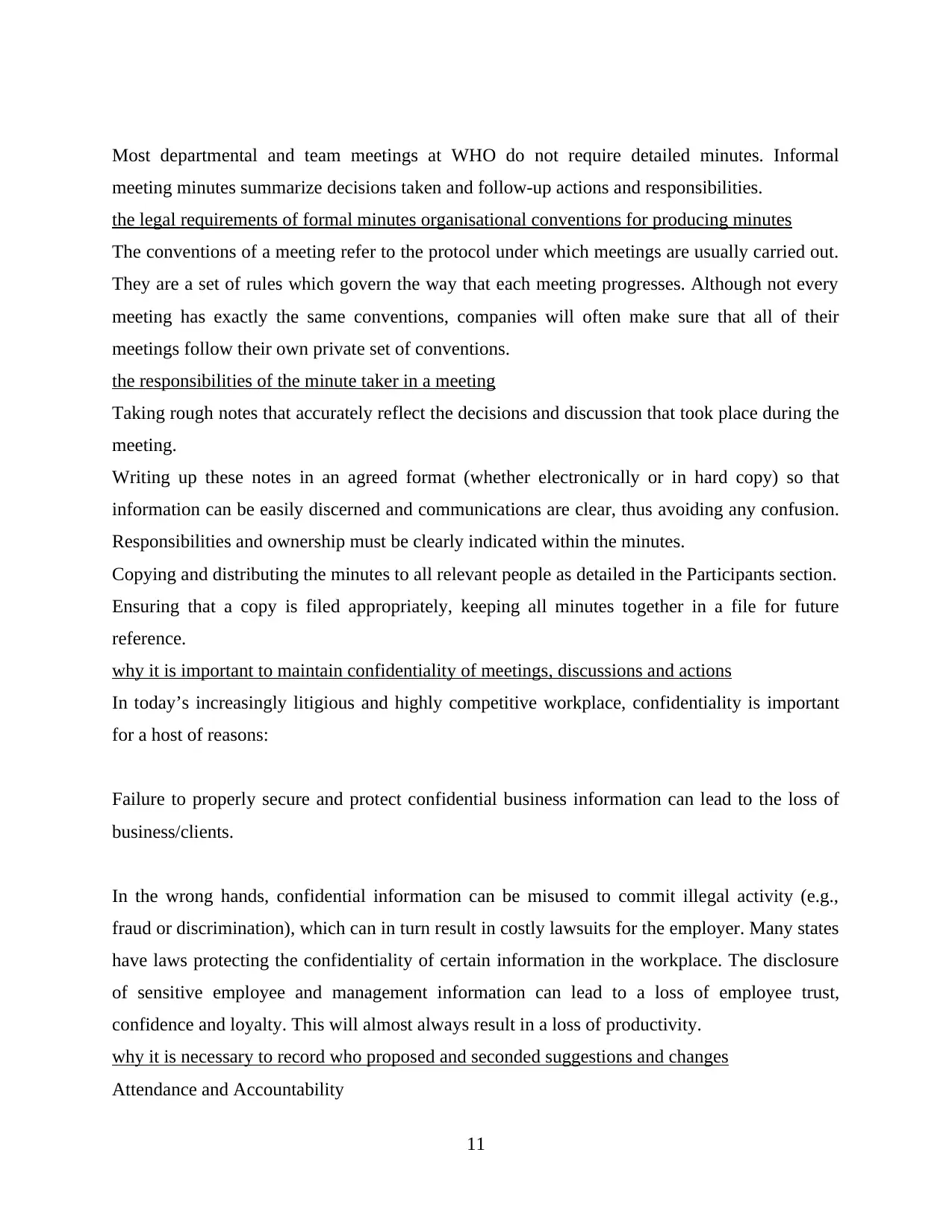
Most departmental and team meetings at WHO do not require detailed minutes. Informal
meeting minutes summarize decisions taken and follow-up actions and responsibilities.
the legal requirements of formal minutes organisational conventions for producing minutes
The conventions of a meeting refer to the protocol under which meetings are usually carried out.
They are a set of rules which govern the way that each meeting progresses. Although not every
meeting has exactly the same conventions, companies will often make sure that all of their
meetings follow their own private set of conventions.
the responsibilities of the minute taker in a meeting
Taking rough notes that accurately reflect the decisions and discussion that took place during the
meeting.
Writing up these notes in an agreed format (whether electronically or in hard copy) so that
information can be easily discerned and communications are clear, thus avoiding any confusion.
Responsibilities and ownership must be clearly indicated within the minutes.
Copying and distributing the minutes to all relevant people as detailed in the Participants section.
Ensuring that a copy is filed appropriately, keeping all minutes together in a file for future
reference.
why it is important to maintain confidentiality of meetings, discussions and actions
In today’s increasingly litigious and highly competitive workplace, confidentiality is important
for a host of reasons:
Failure to properly secure and protect confidential business information can lead to the loss of
business/clients.
In the wrong hands, confidential information can be misused to commit illegal activity (e.g.,
fraud or discrimination), which can in turn result in costly lawsuits for the employer. Many states
have laws protecting the confidentiality of certain information in the workplace. The disclosure
of sensitive employee and management information can lead to a loss of employee trust,
confidence and loyalty. This will almost always result in a loss of productivity.
why it is necessary to record who proposed and seconded suggestions and changes
Attendance and Accountability
11
meeting minutes summarize decisions taken and follow-up actions and responsibilities.
the legal requirements of formal minutes organisational conventions for producing minutes
The conventions of a meeting refer to the protocol under which meetings are usually carried out.
They are a set of rules which govern the way that each meeting progresses. Although not every
meeting has exactly the same conventions, companies will often make sure that all of their
meetings follow their own private set of conventions.
the responsibilities of the minute taker in a meeting
Taking rough notes that accurately reflect the decisions and discussion that took place during the
meeting.
Writing up these notes in an agreed format (whether electronically or in hard copy) so that
information can be easily discerned and communications are clear, thus avoiding any confusion.
Responsibilities and ownership must be clearly indicated within the minutes.
Copying and distributing the minutes to all relevant people as detailed in the Participants section.
Ensuring that a copy is filed appropriately, keeping all minutes together in a file for future
reference.
why it is important to maintain confidentiality of meetings, discussions and actions
In today’s increasingly litigious and highly competitive workplace, confidentiality is important
for a host of reasons:
Failure to properly secure and protect confidential business information can lead to the loss of
business/clients.
In the wrong hands, confidential information can be misused to commit illegal activity (e.g.,
fraud or discrimination), which can in turn result in costly lawsuits for the employer. Many states
have laws protecting the confidentiality of certain information in the workplace. The disclosure
of sensitive employee and management information can lead to a loss of employee trust,
confidence and loyalty. This will almost always result in a loss of productivity.
why it is necessary to record who proposed and seconded suggestions and changes
Attendance and Accountability
11
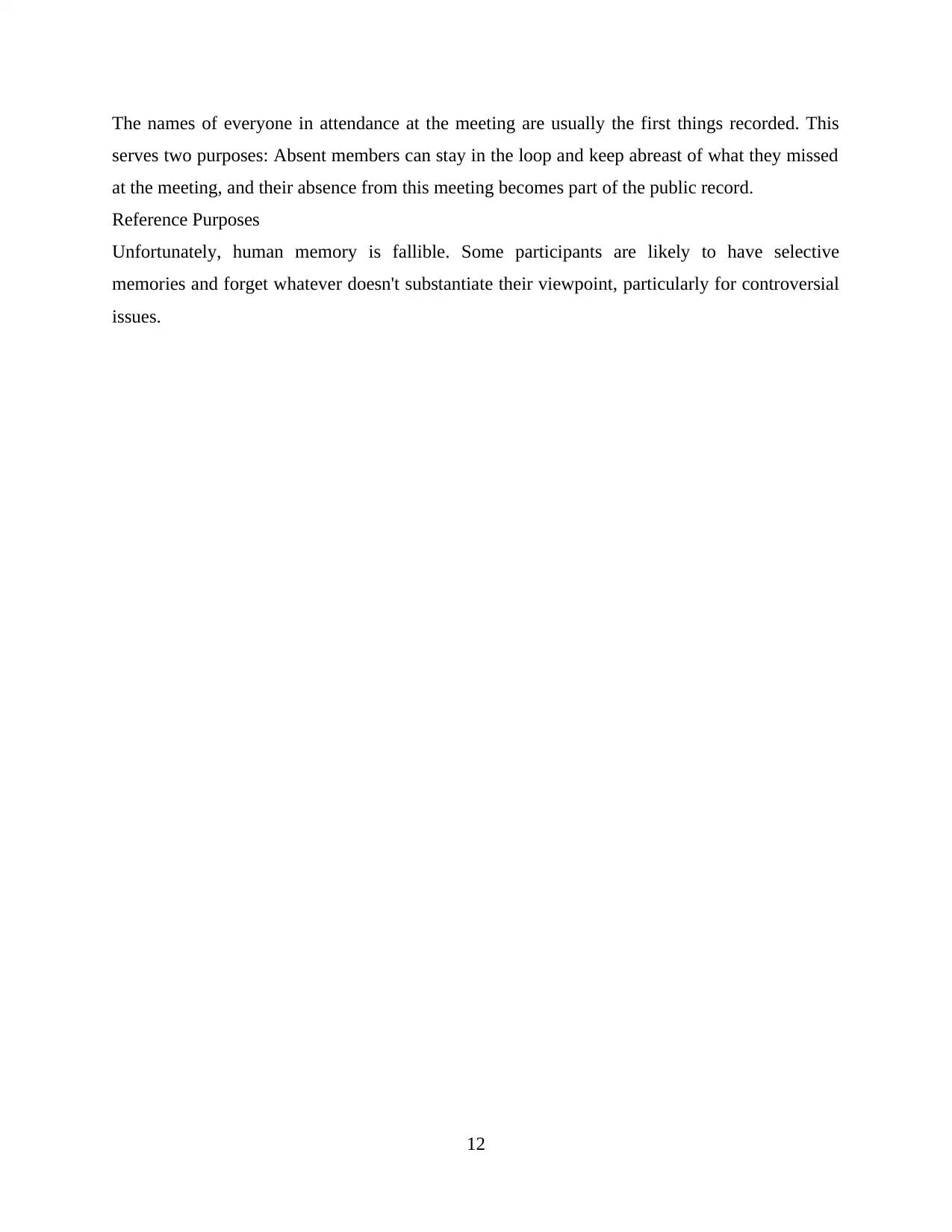
The names of everyone in attendance at the meeting are usually the first things recorded. This
serves two purposes: Absent members can stay in the loop and keep abreast of what they missed
at the meeting, and their absence from this meeting becomes part of the public record.
Reference Purposes
Unfortunately, human memory is fallible. Some participants are likely to have selective
memories and forget whatever doesn't substantiate their viewpoint, particularly for controversial
issues.
12
serves two purposes: Absent members can stay in the loop and keep abreast of what they missed
at the meeting, and their absence from this meeting becomes part of the public record.
Reference Purposes
Unfortunately, human memory is fallible. Some participants are likely to have selective
memories and forget whatever doesn't substantiate their viewpoint, particularly for controversial
issues.
12
Secure Best Marks with AI Grader
Need help grading? Try our AI Grader for instant feedback on your assignments.
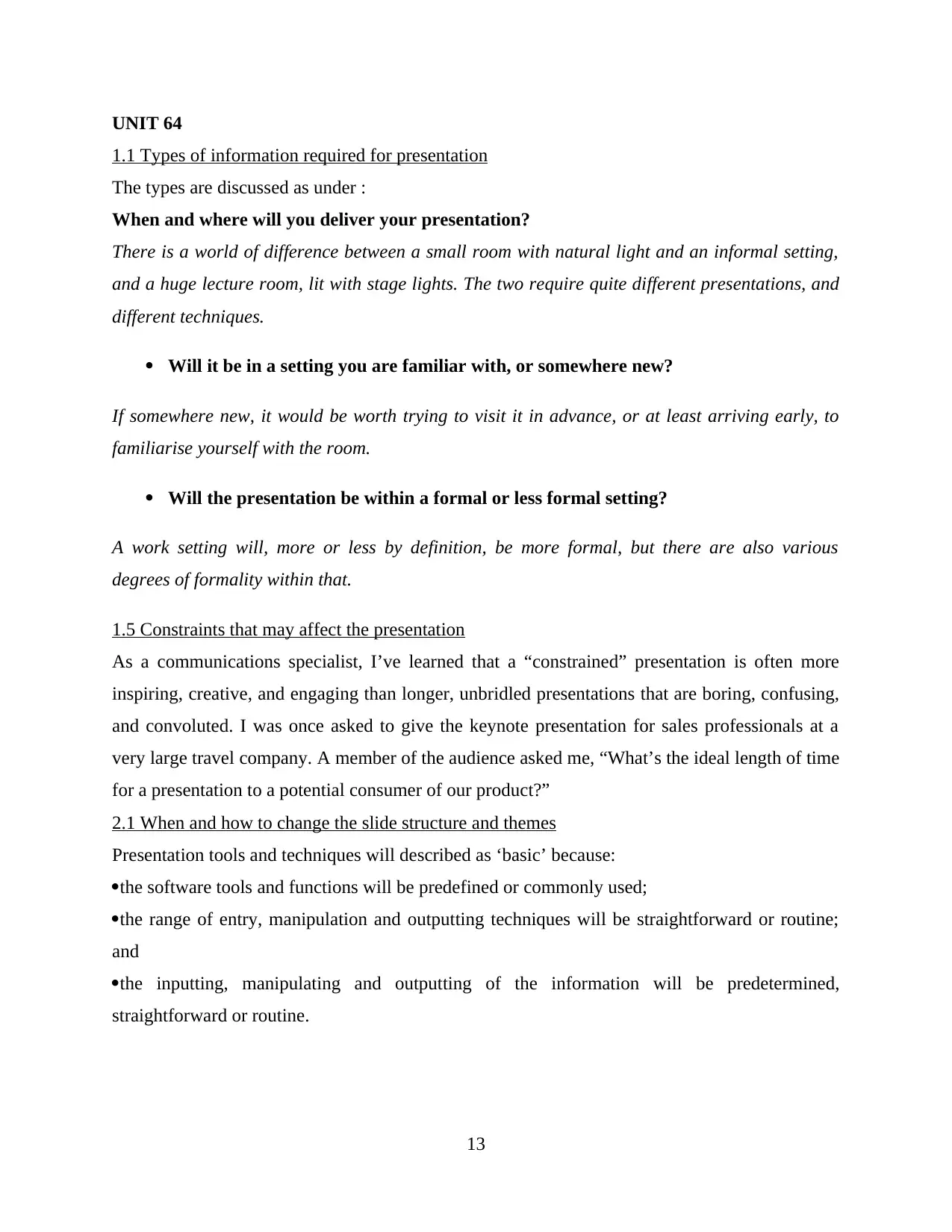
UNIT 64
1.1 Types of information required for presentation
The types are discussed as under :
When and where will you deliver your presentation?
There is a world of difference between a small room with natural light and an informal setting,
and a huge lecture room, lit with stage lights. The two require quite different presentations, and
different techniques.
Will it be in a setting you are familiar with, or somewhere new?
If somewhere new, it would be worth trying to visit it in advance, or at least arriving early, to
familiarise yourself with the room.
Will the presentation be within a formal or less formal setting?
A work setting will, more or less by definition, be more formal, but there are also various
degrees of formality within that.
1.5 Constraints that may affect the presentation
As a communications specialist, I’ve learned that a “constrained” presentation is often more
inspiring, creative, and engaging than longer, unbridled presentations that are boring, confusing,
and convoluted. I was once asked to give the keynote presentation for sales professionals at a
very large travel company. A member of the audience asked me, “What’s the ideal length of time
for a presentation to a potential consumer of our product?”
2.1 When and how to change the slide structure and themes
Presentation tools and techniques will described as ‘basic’ because:
the software tools and functions will be predefined or commonly used;
the range of entry, manipulation and outputting techniques will be straightforward or routine;
and
the inputting, manipulating and outputting of the information will be predetermined,
straightforward or routine.
13
1.1 Types of information required for presentation
The types are discussed as under :
When and where will you deliver your presentation?
There is a world of difference between a small room with natural light and an informal setting,
and a huge lecture room, lit with stage lights. The two require quite different presentations, and
different techniques.
Will it be in a setting you are familiar with, or somewhere new?
If somewhere new, it would be worth trying to visit it in advance, or at least arriving early, to
familiarise yourself with the room.
Will the presentation be within a formal or less formal setting?
A work setting will, more or less by definition, be more formal, but there are also various
degrees of formality within that.
1.5 Constraints that may affect the presentation
As a communications specialist, I’ve learned that a “constrained” presentation is often more
inspiring, creative, and engaging than longer, unbridled presentations that are boring, confusing,
and convoluted. I was once asked to give the keynote presentation for sales professionals at a
very large travel company. A member of the audience asked me, “What’s the ideal length of time
for a presentation to a potential consumer of our product?”
2.1 When and how to change the slide structure and themes
Presentation tools and techniques will described as ‘basic’ because:
the software tools and functions will be predefined or commonly used;
the range of entry, manipulation and outputting techniques will be straightforward or routine;
and
the inputting, manipulating and outputting of the information will be predetermined,
straightforward or routine.
13
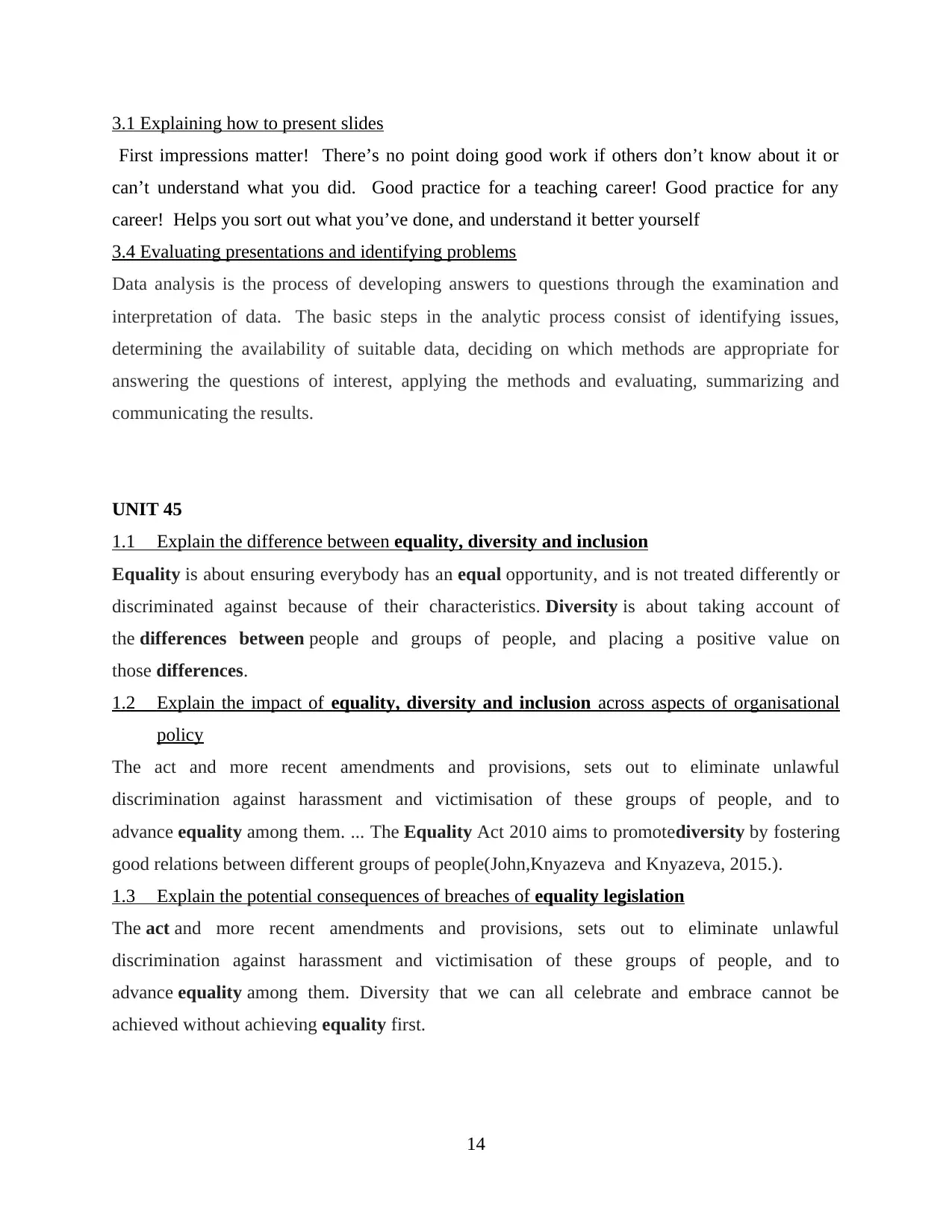
3.1 Explaining how to present slides
First impressions matter! There’s no point doing good work if others don’t know about it or
can’t understand what you did. Good practice for a teaching career! Good practice for any
career! Helps you sort out what you’ve done, and understand it better yourself
3.4 Evaluating presentations and identifying problems
Data analysis is the process of developing answers to questions through the examination and
interpretation of data. The basic steps in the analytic process consist of identifying issues,
determining the availability of suitable data, deciding on which methods are appropriate for
answering the questions of interest, applying the methods and evaluating, summarizing and
communicating the results.
UNIT 45
1.1 Explain the difference between equality, diversity and inclusion
Equality is about ensuring everybody has an equal opportunity, and is not treated differently or
discriminated against because of their characteristics. Diversity is about taking account of
the differences between people and groups of people, and placing a positive value on
those differences.
1.2 Explain the impact of equality, diversity and inclusion across aspects of organisational
policy
The act and more recent amendments and provisions, sets out to eliminate unlawful
discrimination against harassment and victimisation of these groups of people, and to
advance equality among them. ... The Equality Act 2010 aims to promotediversity by fostering
good relations between different groups of people(John,Knyazeva and Knyazeva, 2015.).
1.3 Explain the potential consequences of breaches of equality legislation
The act and more recent amendments and provisions, sets out to eliminate unlawful
discrimination against harassment and victimisation of these groups of people, and to
advance equality among them. Diversity that we can all celebrate and embrace cannot be
achieved without achieving equality first.
14
First impressions matter! There’s no point doing good work if others don’t know about it or
can’t understand what you did. Good practice for a teaching career! Good practice for any
career! Helps you sort out what you’ve done, and understand it better yourself
3.4 Evaluating presentations and identifying problems
Data analysis is the process of developing answers to questions through the examination and
interpretation of data. The basic steps in the analytic process consist of identifying issues,
determining the availability of suitable data, deciding on which methods are appropriate for
answering the questions of interest, applying the methods and evaluating, summarizing and
communicating the results.
UNIT 45
1.1 Explain the difference between equality, diversity and inclusion
Equality is about ensuring everybody has an equal opportunity, and is not treated differently or
discriminated against because of their characteristics. Diversity is about taking account of
the differences between people and groups of people, and placing a positive value on
those differences.
1.2 Explain the impact of equality, diversity and inclusion across aspects of organisational
policy
The act and more recent amendments and provisions, sets out to eliminate unlawful
discrimination against harassment and victimisation of these groups of people, and to
advance equality among them. ... The Equality Act 2010 aims to promotediversity by fostering
good relations between different groups of people(John,Knyazeva and Knyazeva, 2015.).
1.3 Explain the potential consequences of breaches of equality legislation
The act and more recent amendments and provisions, sets out to eliminate unlawful
discrimination against harassment and victimisation of these groups of people, and to
advance equality among them. Diversity that we can all celebrate and embrace cannot be
achieved without achieving equality first.
14
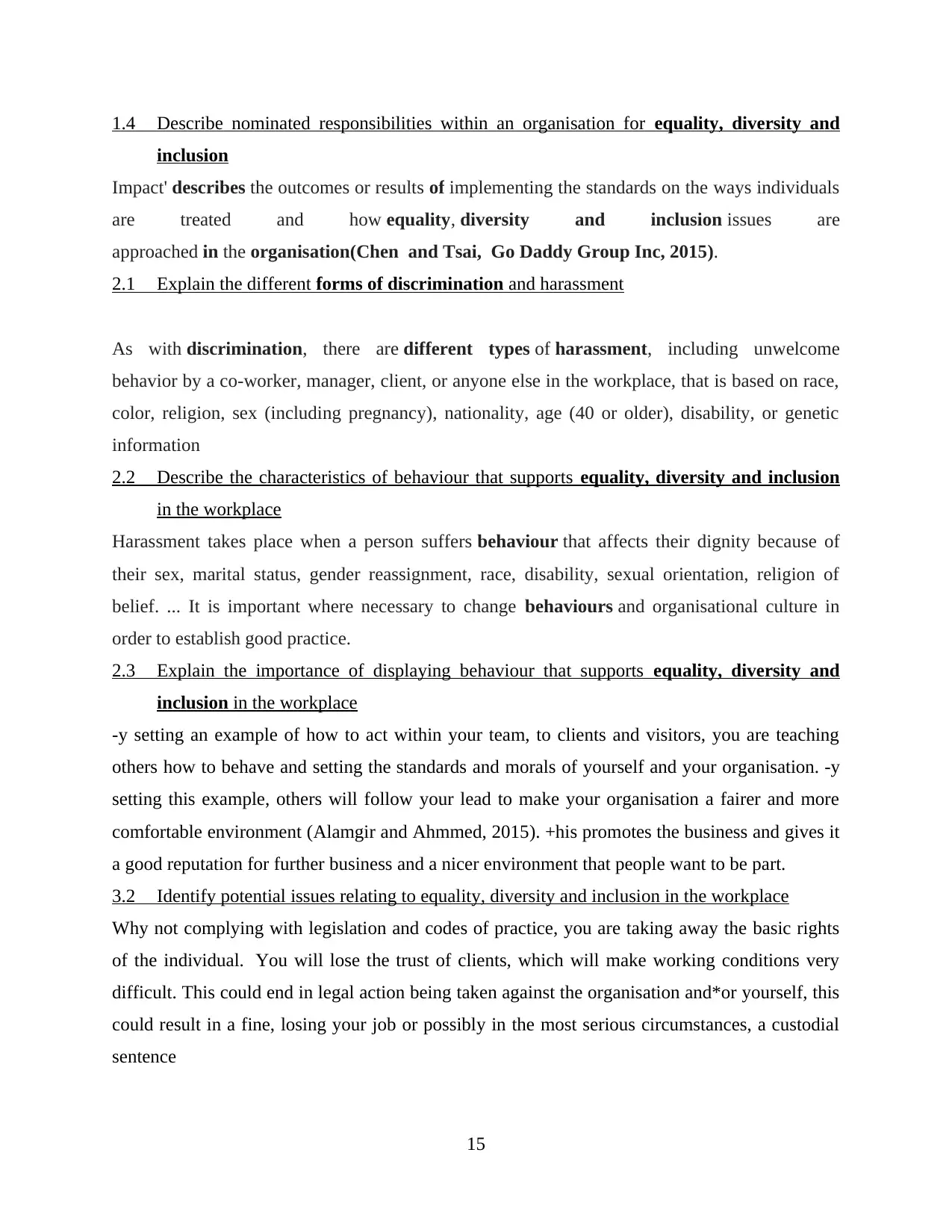
1.4 Describe nominated responsibilities within an organisation for equality, diversity and
inclusion
Impact' describes the outcomes or results of implementing the standards on the ways individuals
are treated and how equality, diversity and inclusion issues are
approached in the organisation(Chen and Tsai, Go Daddy Group Inc, 2015).
2.1 Explain the different forms of discrimination and harassment
As with discrimination, there are different types of harassment, including unwelcome
behavior by a co-worker, manager, client, or anyone else in the workplace, that is based on race,
color, religion, sex (including pregnancy), nationality, age (40 or older), disability, or genetic
information
2.2 Describe the characteristics of behaviour that supports equality, diversity and inclusion
in the workplace
Harassment takes place when a person suffers behaviour that affects their dignity because of
their sex, marital status, gender reassignment, race, disability, sexual orientation, religion of
belief. ... It is important where necessary to change behaviours and organisational culture in
order to establish good practice.
2.3 Explain the importance of displaying behaviour that supports equality, diversity and
inclusion in the workplace
-y setting an example of how to act within your team, to clients and visitors, you are teaching
others how to behave and setting the standards and morals of yourself and your organisation. -y
setting this example, others will follow your lead to make your organisation a fairer and more
comfortable environment (Alamgir and Ahmmed, 2015). +his promotes the business and gives it
a good reputation for further business and a nicer environment that people want to be part.
3.2 Identify potential issues relating to equality, diversity and inclusion in the workplace
Why not complying with legislation and codes of practice, you are taking away the basic rights
of the individual. You will lose the trust of clients, which will make working conditions very
difficult. This could end in legal action being taken against the organisation and*or yourself, this
could result in a fine, losing your job or possibly in the most serious circumstances, a custodial
sentence
15
inclusion
Impact' describes the outcomes or results of implementing the standards on the ways individuals
are treated and how equality, diversity and inclusion issues are
approached in the organisation(Chen and Tsai, Go Daddy Group Inc, 2015).
2.1 Explain the different forms of discrimination and harassment
As with discrimination, there are different types of harassment, including unwelcome
behavior by a co-worker, manager, client, or anyone else in the workplace, that is based on race,
color, religion, sex (including pregnancy), nationality, age (40 or older), disability, or genetic
information
2.2 Describe the characteristics of behaviour that supports equality, diversity and inclusion
in the workplace
Harassment takes place when a person suffers behaviour that affects their dignity because of
their sex, marital status, gender reassignment, race, disability, sexual orientation, religion of
belief. ... It is important where necessary to change behaviours and organisational culture in
order to establish good practice.
2.3 Explain the importance of displaying behaviour that supports equality, diversity and
inclusion in the workplace
-y setting an example of how to act within your team, to clients and visitors, you are teaching
others how to behave and setting the standards and morals of yourself and your organisation. -y
setting this example, others will follow your lead to make your organisation a fairer and more
comfortable environment (Alamgir and Ahmmed, 2015). +his promotes the business and gives it
a good reputation for further business and a nicer environment that people want to be part.
3.2 Identify potential issues relating to equality, diversity and inclusion in the workplace
Why not complying with legislation and codes of practice, you are taking away the basic rights
of the individual. You will lose the trust of clients, which will make working conditions very
difficult. This could end in legal action being taken against the organisation and*or yourself, this
could result in a fine, losing your job or possibly in the most serious circumstances, a custodial
sentence
15
Paraphrase This Document
Need a fresh take? Get an instant paraphrase of this document with our AI Paraphraser
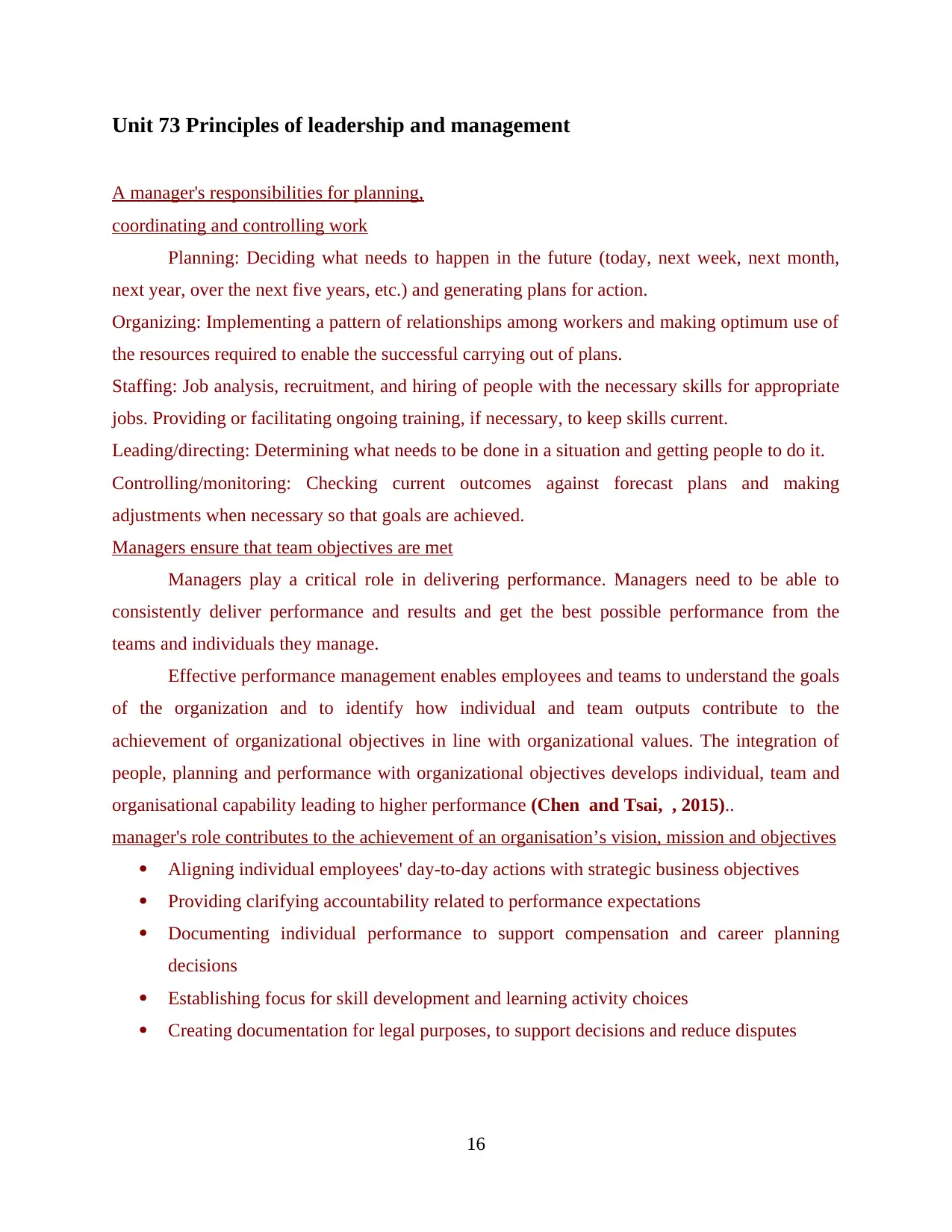
Unit 73 Principles of leadership and management
A manager's responsibilities for planning,
coordinating and controlling work
Planning: Deciding what needs to happen in the future (today, next week, next month,
next year, over the next five years, etc.) and generating plans for action.
Organizing: Implementing a pattern of relationships among workers and making optimum use of
the resources required to enable the successful carrying out of plans.
Staffing: Job analysis, recruitment, and hiring of people with the necessary skills for appropriate
jobs. Providing or facilitating ongoing training, if necessary, to keep skills current.
Leading/directing: Determining what needs to be done in a situation and getting people to do it.
Controlling/monitoring: Checking current outcomes against forecast plans and making
adjustments when necessary so that goals are achieved.
Managers ensure that team objectives are met
Managers play a critical role in delivering performance. Managers need to be able to
consistently deliver performance and results and get the best possible performance from the
teams and individuals they manage.
Effective performance management enables employees and teams to understand the goals
of the organization and to identify how individual and team outputs contribute to the
achievement of organizational objectives in line with organizational values. The integration of
people, planning and performance with organizational objectives develops individual, team and
organisational capability leading to higher performance (Chen and Tsai, , 2015)..
manager's role contributes to the achievement of an organisation’s vision, mission and objectives
Aligning individual employees' day-to-day actions with strategic business objectives
Providing clarifying accountability related to performance expectations
Documenting individual performance to support compensation and career planning
decisions
Establishing focus for skill development and learning activity choices
Creating documentation for legal purposes, to support decisions and reduce disputes
16
A manager's responsibilities for planning,
coordinating and controlling work
Planning: Deciding what needs to happen in the future (today, next week, next month,
next year, over the next five years, etc.) and generating plans for action.
Organizing: Implementing a pattern of relationships among workers and making optimum use of
the resources required to enable the successful carrying out of plans.
Staffing: Job analysis, recruitment, and hiring of people with the necessary skills for appropriate
jobs. Providing or facilitating ongoing training, if necessary, to keep skills current.
Leading/directing: Determining what needs to be done in a situation and getting people to do it.
Controlling/monitoring: Checking current outcomes against forecast plans and making
adjustments when necessary so that goals are achieved.
Managers ensure that team objectives are met
Managers play a critical role in delivering performance. Managers need to be able to
consistently deliver performance and results and get the best possible performance from the
teams and individuals they manage.
Effective performance management enables employees and teams to understand the goals
of the organization and to identify how individual and team outputs contribute to the
achievement of organizational objectives in line with organizational values. The integration of
people, planning and performance with organizational objectives develops individual, team and
organisational capability leading to higher performance (Chen and Tsai, , 2015)..
manager's role contributes to the achievement of an organisation’s vision, mission and objectives
Aligning individual employees' day-to-day actions with strategic business objectives
Providing clarifying accountability related to performance expectations
Documenting individual performance to support compensation and career planning
decisions
Establishing focus for skill development and learning activity choices
Creating documentation for legal purposes, to support decisions and reduce disputes
16
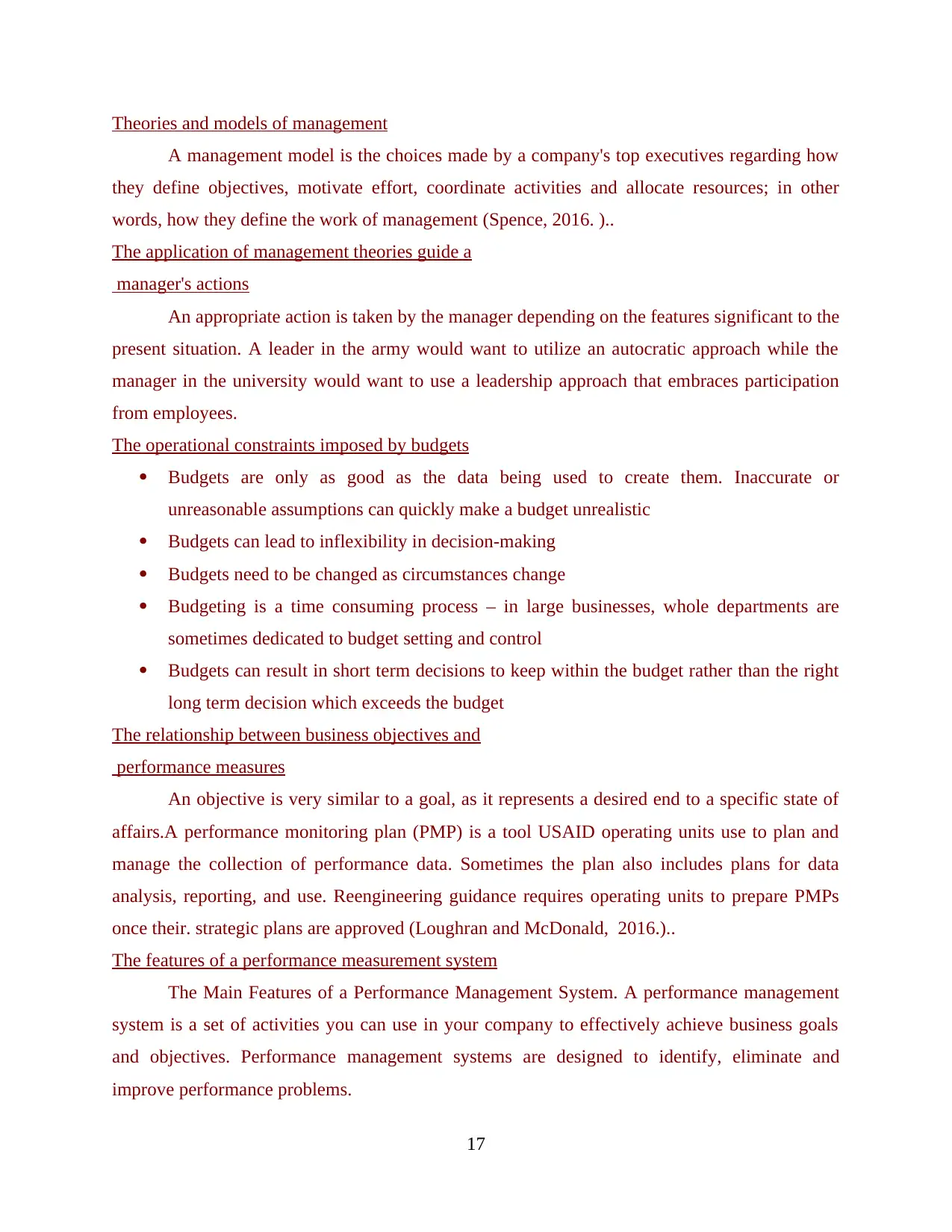
Theories and models of management
A management model is the choices made by a company's top executives regarding how
they define objectives, motivate effort, coordinate activities and allocate resources; in other
words, how they define the work of management (Spence, 2016. )..
The application of management theories guide a
manager's actions
An appropriate action is taken by the manager depending on the features significant to the
present situation. A leader in the army would want to utilize an autocratic approach while the
manager in the university would want to use a leadership approach that embraces participation
from employees.
The operational constraints imposed by budgets
Budgets are only as good as the data being used to create them. Inaccurate or
unreasonable assumptions can quickly make a budget unrealistic
Budgets can lead to inflexibility in decision-making
Budgets need to be changed as circumstances change
Budgeting is a time consuming process – in large businesses, whole departments are
sometimes dedicated to budget setting and control
Budgets can result in short term decisions to keep within the budget rather than the right
long term decision which exceeds the budget
The relationship between business objectives and
performance measures
An objective is very similar to a goal, as it represents a desired end to a specific state of
affairs.A performance monitoring plan (PMP) is a tool USAID operating units use to plan and
manage the collection of performance data. Sometimes the plan also includes plans for data
analysis, reporting, and use. Reengineering guidance requires operating units to prepare PMPs
once their. strategic plans are approved (Loughran and McDonald, 2016.)..
The features of a performance measurement system
The Main Features of a Performance Management System. A performance management
system is a set of activities you can use in your company to effectively achieve business goals
and objectives. Performance management systems are designed to identify, eliminate and
improve performance problems.
17
A management model is the choices made by a company's top executives regarding how
they define objectives, motivate effort, coordinate activities and allocate resources; in other
words, how they define the work of management (Spence, 2016. )..
The application of management theories guide a
manager's actions
An appropriate action is taken by the manager depending on the features significant to the
present situation. A leader in the army would want to utilize an autocratic approach while the
manager in the university would want to use a leadership approach that embraces participation
from employees.
The operational constraints imposed by budgets
Budgets are only as good as the data being used to create them. Inaccurate or
unreasonable assumptions can quickly make a budget unrealistic
Budgets can lead to inflexibility in decision-making
Budgets need to be changed as circumstances change
Budgeting is a time consuming process – in large businesses, whole departments are
sometimes dedicated to budget setting and control
Budgets can result in short term decisions to keep within the budget rather than the right
long term decision which exceeds the budget
The relationship between business objectives and
performance measures
An objective is very similar to a goal, as it represents a desired end to a specific state of
affairs.A performance monitoring plan (PMP) is a tool USAID operating units use to plan and
manage the collection of performance data. Sometimes the plan also includes plans for data
analysis, reporting, and use. Reengineering guidance requires operating units to prepare PMPs
once their. strategic plans are approved (Loughran and McDonald, 2016.)..
The features of a performance measurement system
The Main Features of a Performance Management System. A performance management
system is a set of activities you can use in your company to effectively achieve business goals
and objectives. Performance management systems are designed to identify, eliminate and
improve performance problems.
17
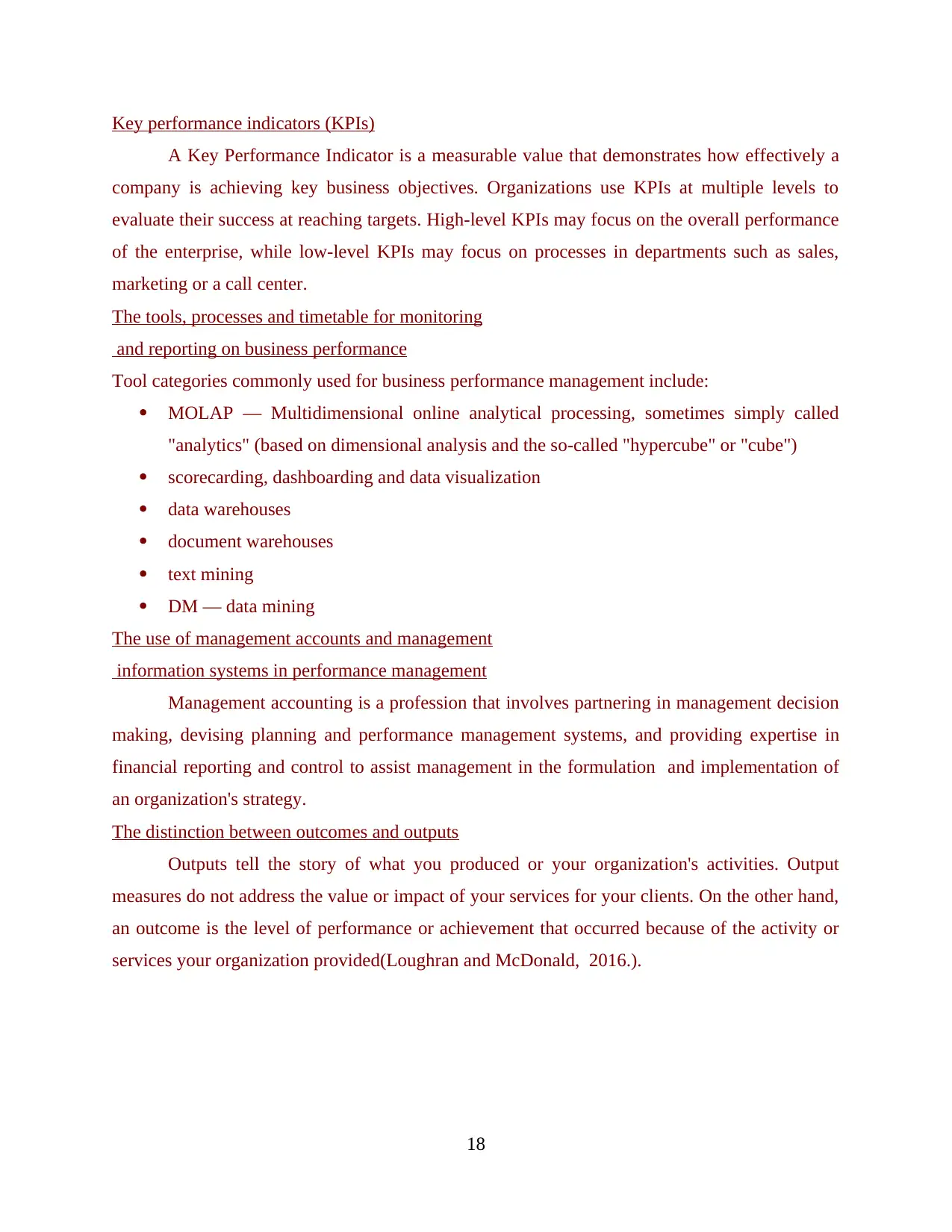
Key performance indicators (KPIs)
A Key Performance Indicator is a measurable value that demonstrates how effectively a
company is achieving key business objectives. Organizations use KPIs at multiple levels to
evaluate their success at reaching targets. High-level KPIs may focus on the overall performance
of the enterprise, while low-level KPIs may focus on processes in departments such as sales,
marketing or a call center.
The tools, processes and timetable for monitoring
and reporting on business performance
Tool categories commonly used for business performance management include:
MOLAP — Multidimensional online analytical processing, sometimes simply called
"analytics" (based on dimensional analysis and the so-called "hypercube" or "cube")
scorecarding, dashboarding and data visualization
data warehouses
document warehouses
text mining
DM — data mining
The use of management accounts and management
information systems in performance management
Management accounting is a profession that involves partnering in management decision
making, devising planning and performance management systems, and providing expertise in
financial reporting and control to assist management in the formulation and implementation of
an organization's strategy.
The distinction between outcomes and outputs
Outputs tell the story of what you produced or your organization's activities. Output
measures do not address the value or impact of your services for your clients. On the other hand,
an outcome is the level of performance or achievement that occurred because of the activity or
services your organization provided(Loughran and McDonald, 2016.).
18
A Key Performance Indicator is a measurable value that demonstrates how effectively a
company is achieving key business objectives. Organizations use KPIs at multiple levels to
evaluate their success at reaching targets. High-level KPIs may focus on the overall performance
of the enterprise, while low-level KPIs may focus on processes in departments such as sales,
marketing or a call center.
The tools, processes and timetable for monitoring
and reporting on business performance
Tool categories commonly used for business performance management include:
MOLAP — Multidimensional online analytical processing, sometimes simply called
"analytics" (based on dimensional analysis and the so-called "hypercube" or "cube")
scorecarding, dashboarding and data visualization
data warehouses
document warehouses
text mining
DM — data mining
The use of management accounts and management
information systems in performance management
Management accounting is a profession that involves partnering in management decision
making, devising planning and performance management systems, and providing expertise in
financial reporting and control to assist management in the formulation and implementation of
an organization's strategy.
The distinction between outcomes and outputs
Outputs tell the story of what you produced or your organization's activities. Output
measures do not address the value or impact of your services for your clients. On the other hand,
an outcome is the level of performance or achievement that occurred because of the activity or
services your organization provided(Loughran and McDonald, 2016.).
18
Secure Best Marks with AI Grader
Need help grading? Try our AI Grader for instant feedback on your assignments.
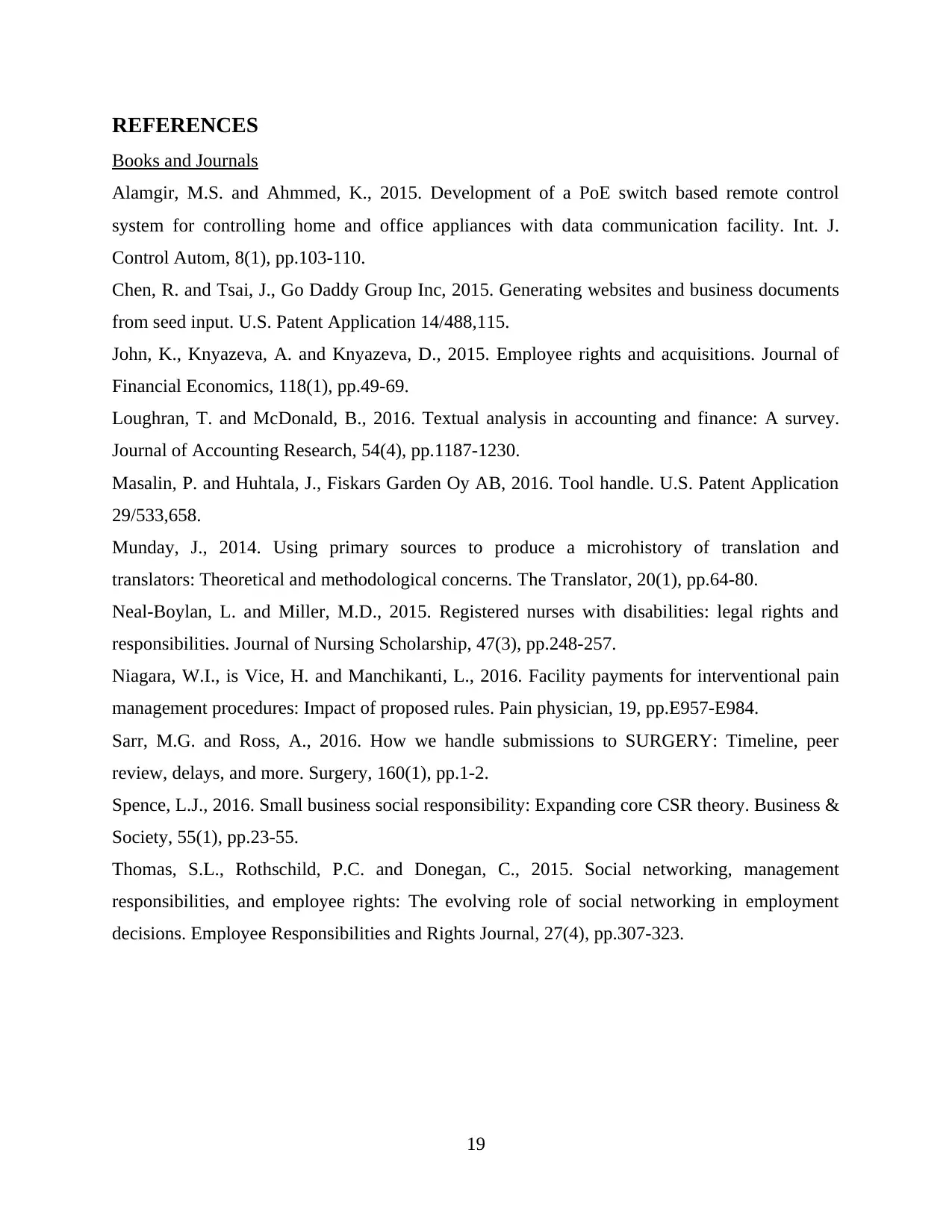
REFERENCES
Books and Journals
Alamgir, M.S. and Ahmmed, K., 2015. Development of a PoE switch based remote control
system for controlling home and office appliances with data communication facility. Int. J.
Control Autom, 8(1), pp.103-110.
Chen, R. and Tsai, J., Go Daddy Group Inc, 2015. Generating websites and business documents
from seed input. U.S. Patent Application 14/488,115.
John, K., Knyazeva, A. and Knyazeva, D., 2015. Employee rights and acquisitions. Journal of
Financial Economics, 118(1), pp.49-69.
Loughran, T. and McDonald, B., 2016. Textual analysis in accounting and finance: A survey.
Journal of Accounting Research, 54(4), pp.1187-1230.
Masalin, P. and Huhtala, J., Fiskars Garden Oy AB, 2016. Tool handle. U.S. Patent Application
29/533,658.
Munday, J., 2014. Using primary sources to produce a microhistory of translation and
translators: Theoretical and methodological concerns. The Translator, 20(1), pp.64-80.
Neal‐Boylan, L. and Miller, M.D., 2015. Registered nurses with disabilities: legal rights and
responsibilities. Journal of Nursing Scholarship, 47(3), pp.248-257.
Niagara, W.I., is Vice, H. and Manchikanti, L., 2016. Facility payments for interventional pain
management procedures: Impact of proposed rules. Pain physician, 19, pp.E957-E984.
Sarr, M.G. and Ross, A., 2016. How we handle submissions to SURGERY: Timeline, peer
review, delays, and more. Surgery, 160(1), pp.1-2.
Spence, L.J., 2016. Small business social responsibility: Expanding core CSR theory. Business &
Society, 55(1), pp.23-55.
Thomas, S.L., Rothschild, P.C. and Donegan, C., 2015. Social networking, management
responsibilities, and employee rights: The evolving role of social networking in employment
decisions. Employee Responsibilities and Rights Journal, 27(4), pp.307-323.
19
Books and Journals
Alamgir, M.S. and Ahmmed, K., 2015. Development of a PoE switch based remote control
system for controlling home and office appliances with data communication facility. Int. J.
Control Autom, 8(1), pp.103-110.
Chen, R. and Tsai, J., Go Daddy Group Inc, 2015. Generating websites and business documents
from seed input. U.S. Patent Application 14/488,115.
John, K., Knyazeva, A. and Knyazeva, D., 2015. Employee rights and acquisitions. Journal of
Financial Economics, 118(1), pp.49-69.
Loughran, T. and McDonald, B., 2016. Textual analysis in accounting and finance: A survey.
Journal of Accounting Research, 54(4), pp.1187-1230.
Masalin, P. and Huhtala, J., Fiskars Garden Oy AB, 2016. Tool handle. U.S. Patent Application
29/533,658.
Munday, J., 2014. Using primary sources to produce a microhistory of translation and
translators: Theoretical and methodological concerns. The Translator, 20(1), pp.64-80.
Neal‐Boylan, L. and Miller, M.D., 2015. Registered nurses with disabilities: legal rights and
responsibilities. Journal of Nursing Scholarship, 47(3), pp.248-257.
Niagara, W.I., is Vice, H. and Manchikanti, L., 2016. Facility payments for interventional pain
management procedures: Impact of proposed rules. Pain physician, 19, pp.E957-E984.
Sarr, M.G. and Ross, A., 2016. How we handle submissions to SURGERY: Timeline, peer
review, delays, and more. Surgery, 160(1), pp.1-2.
Spence, L.J., 2016. Small business social responsibility: Expanding core CSR theory. Business &
Society, 55(1), pp.23-55.
Thomas, S.L., Rothschild, P.C. and Donegan, C., 2015. Social networking, management
responsibilities, and employee rights: The evolving role of social networking in employment
decisions. Employee Responsibilities and Rights Journal, 27(4), pp.307-323.
19
1 out of 23
Related Documents
Your All-in-One AI-Powered Toolkit for Academic Success.
+13062052269
info@desklib.com
Available 24*7 on WhatsApp / Email
![[object Object]](/_next/static/media/star-bottom.7253800d.svg)
Unlock your academic potential
© 2024 | Zucol Services PVT LTD | All rights reserved.





